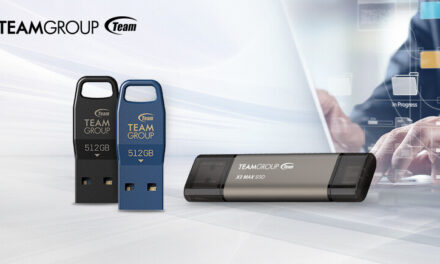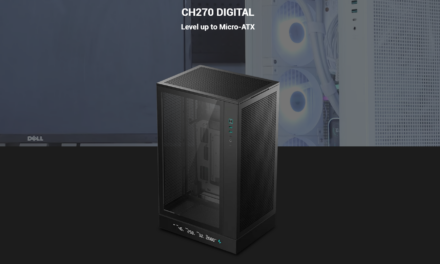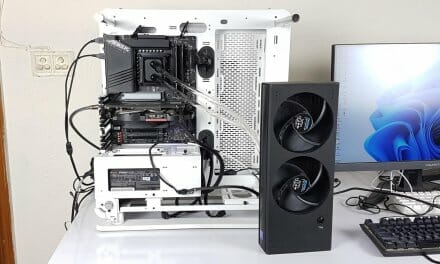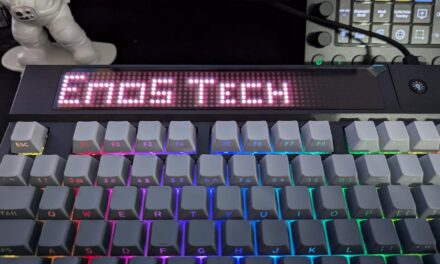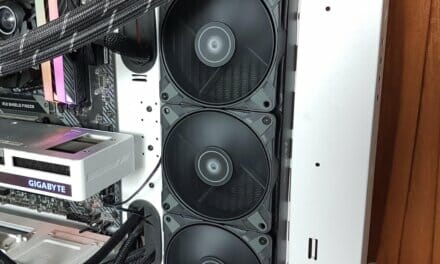
HYTE THICC Q60 240MM LCD AIO Review
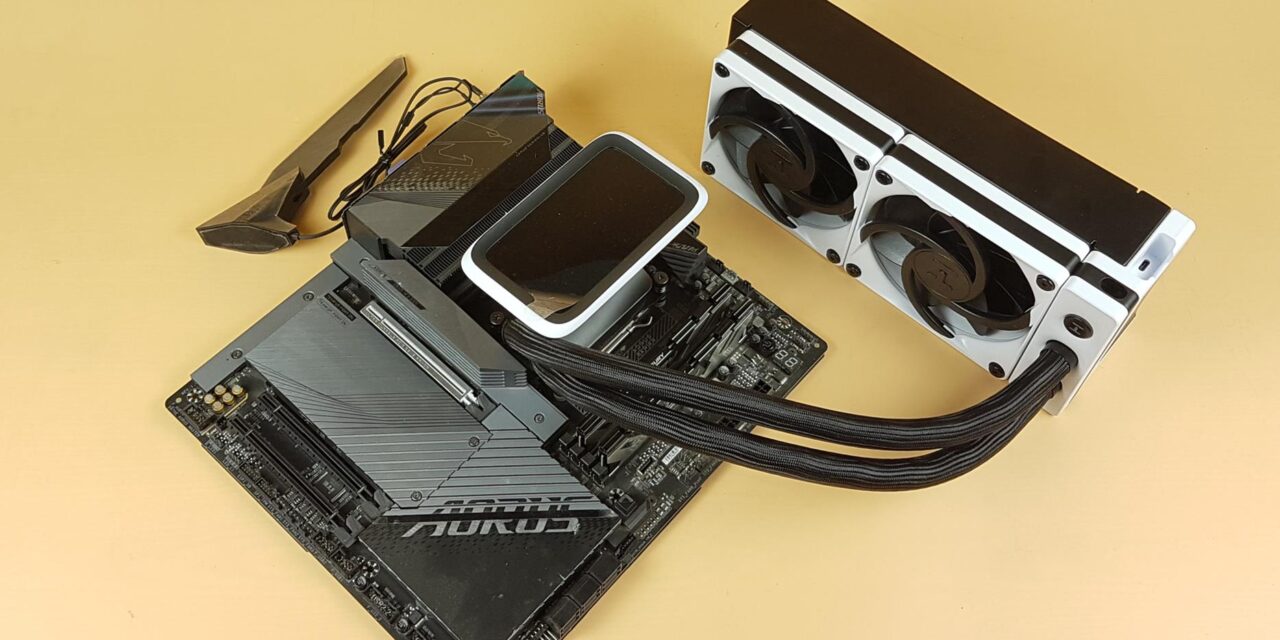
HYTE is among a few brands that come and proven an instant success. Its innovate new designs speak for themselves and users have welcome the brand open heartily. Y60 was a remarkable PC Case that quickly gained attraction and proven a high success for the brand. Then came the Q60 which is like brand said, “240mm smol, 52mm thick” is a “short king”.
Ever heard of a liquid cooler that has its own digital processing unit? Well, HYTE has that for you. Say hello to THICC Q60. This is a 240mm size AIO cooler that has a massive 52mm thick radiator with overall height or thickness of 84mm provides ginormous cooling surface backed by powerful 32mm thick FP12 fans.
The killer feature is Nexus link that literally hides any cable connection on the block and on the radiator. Only cable that you need is a Nexus cable using two USB Type-C connectors. And then there is a crisp, vivid, and brilliant 5” IPS LCD display providing 720×1280 resolution with 60Hz refresh rate and 300 nits of brightness. The same device is equipped with 42-pixel qRGB array for a brilliant backlighting effect.
The salient features include:
- 5” Ultraslim IPS Display
- 42-Pixel qRGB Array
- Double-Hinged Floating Spout
- Dual Harmonic Pumps
- Ginormous Heat Exchanger
- 32mm THICC FP12 Fans
- Nexus Link Primary Node
THICC Q60 Specifications
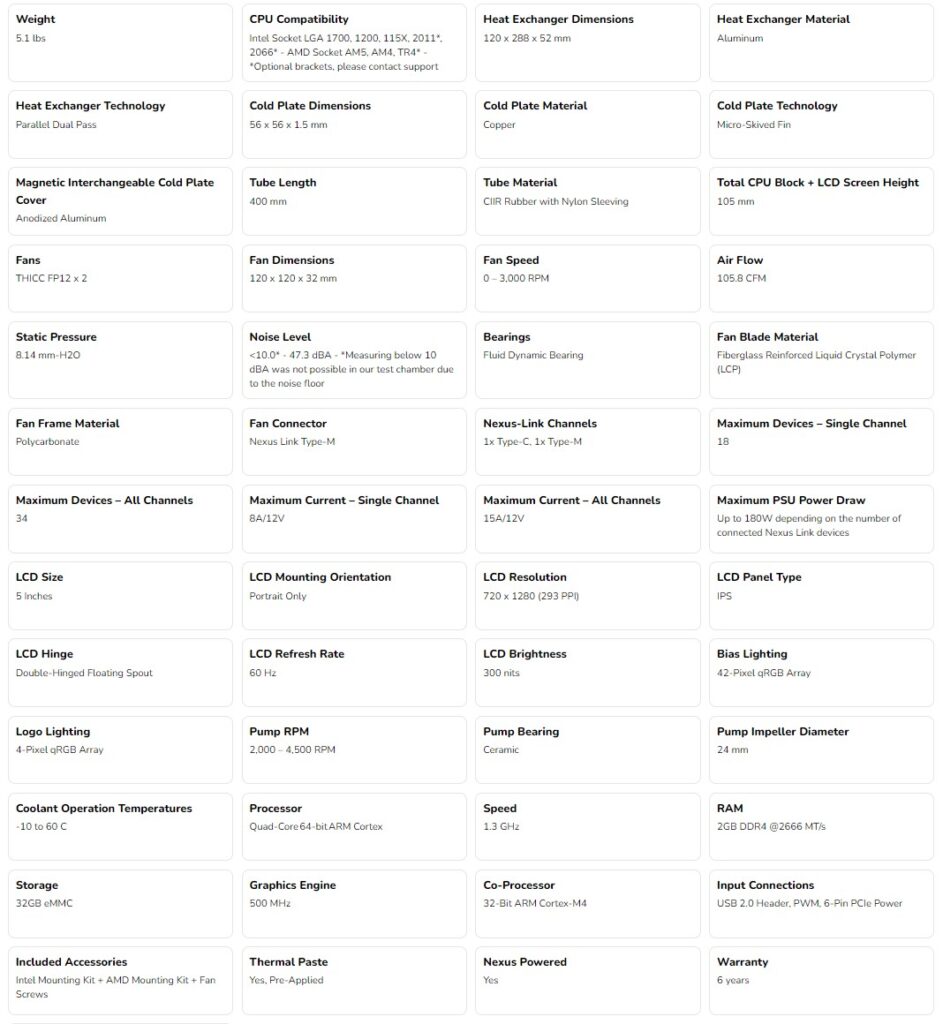
Packing and Unboxing
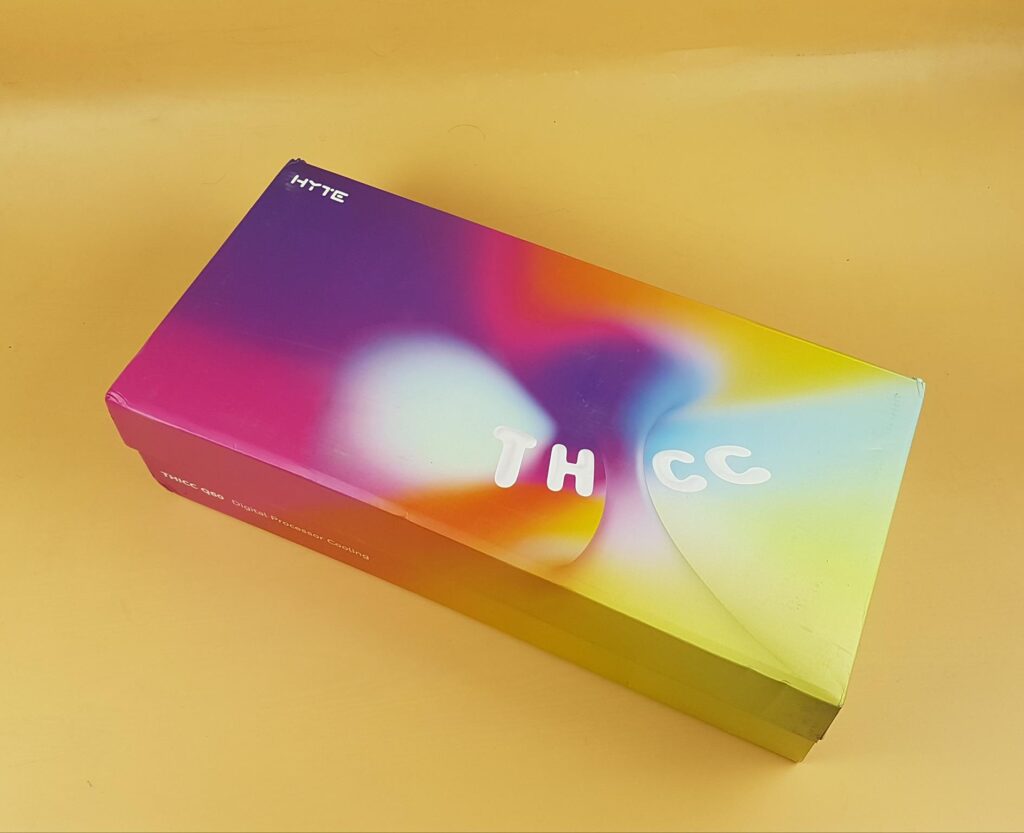
The cooler is shipped inside a large size cardboard packing box. The packing box size of standard 360mm size coolers is even less than this packing box.
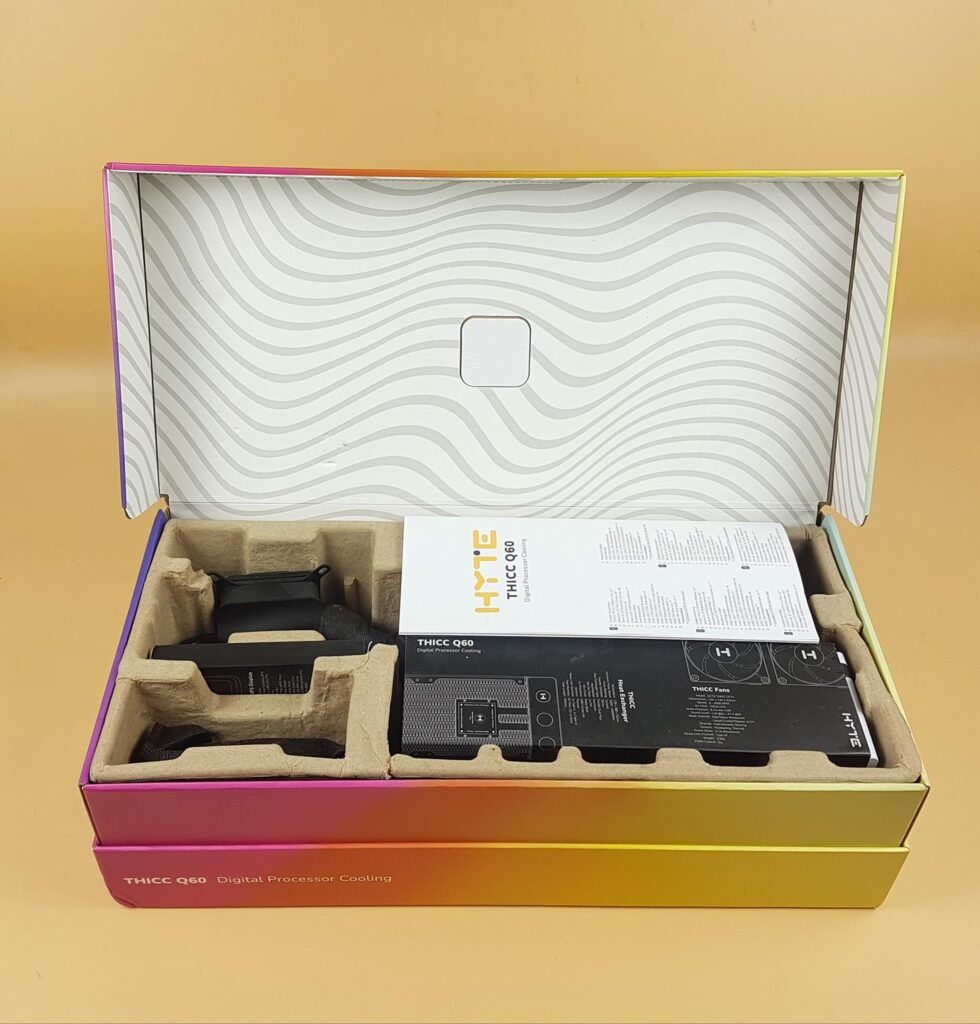
There is an inner container on which the contents are tucked nicely and securely in each compartment.
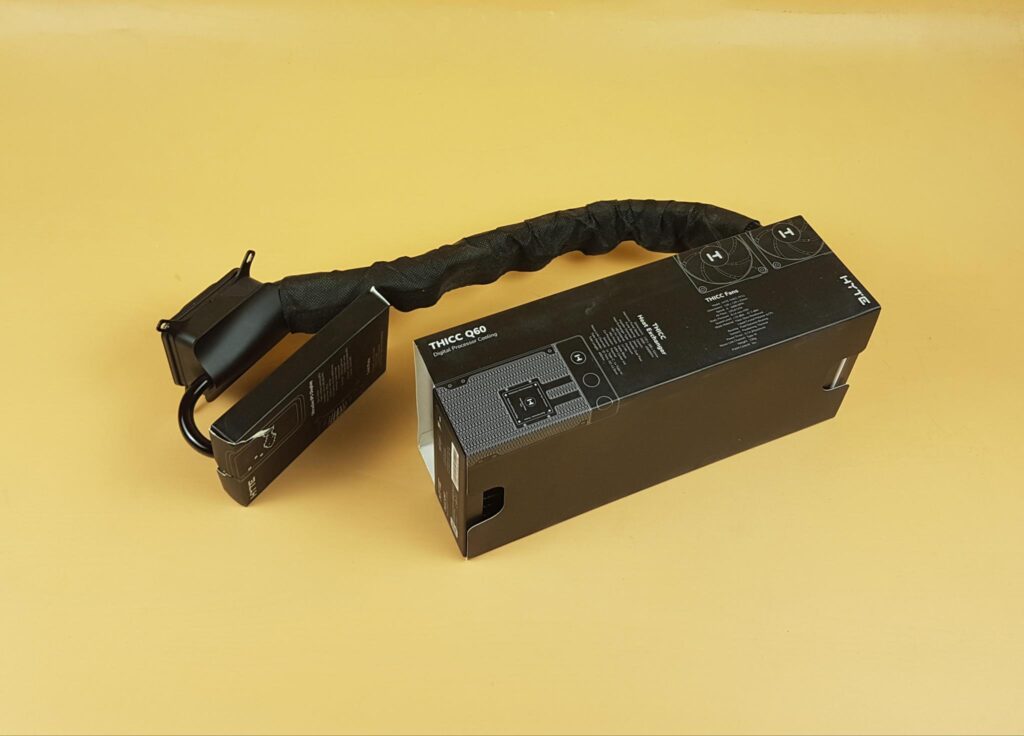
The fans come pre-installed over the radiator and there is a paperboard cover over the assembly. The hoses are also concealed with reusable Velcro style cover.
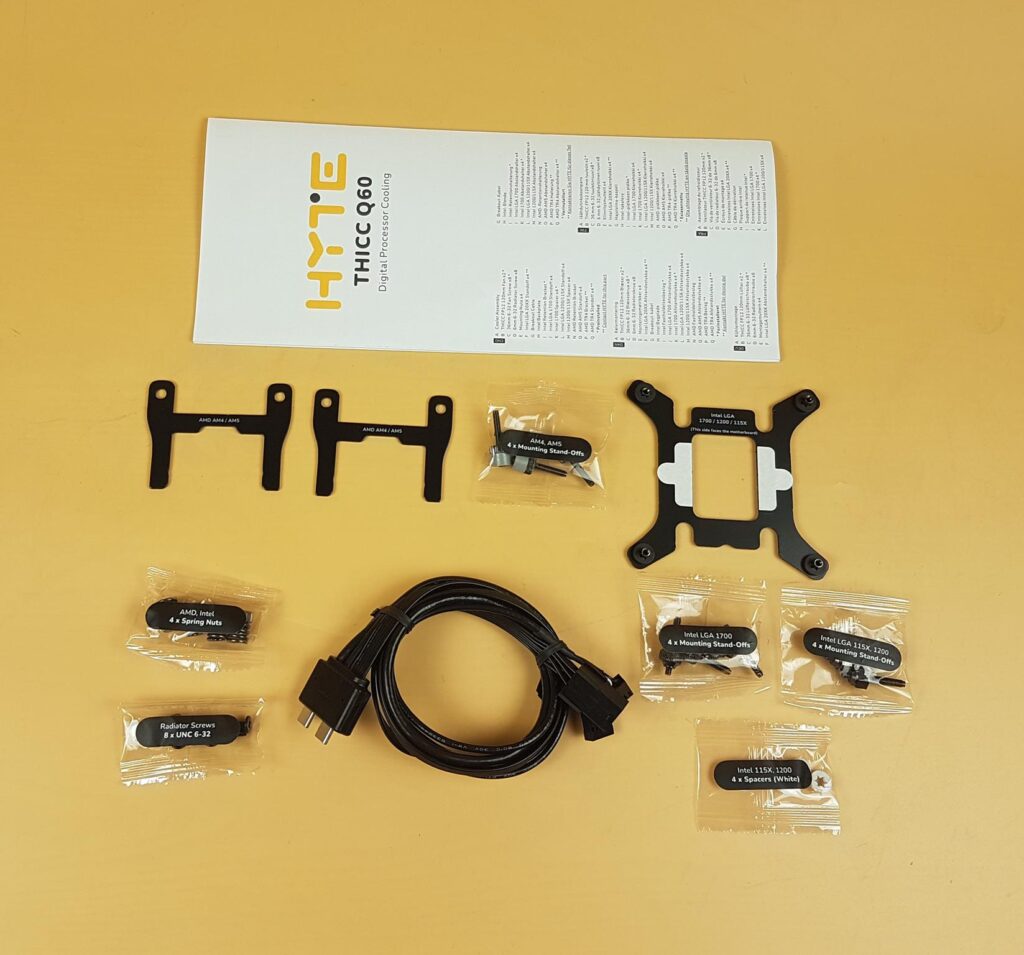
The following are provided:
- 1x 240mm Liquid Cooler
- 1x Intel Back plate
- 2x Intel Brackets[ Pre-installed]
- 2x AMD Brackets
- 4x AMD Standoff Screws
- 4x Intel LGA1700 Screws
- 4x Intel LGA1200/115x Screws
- 4x Intel LGA1200/115x Spacers
- 4x Spring Nuts
- 8x UNC 6-32 Radiator Screws
- 1x Nexus Link Cable
- Installation Guide
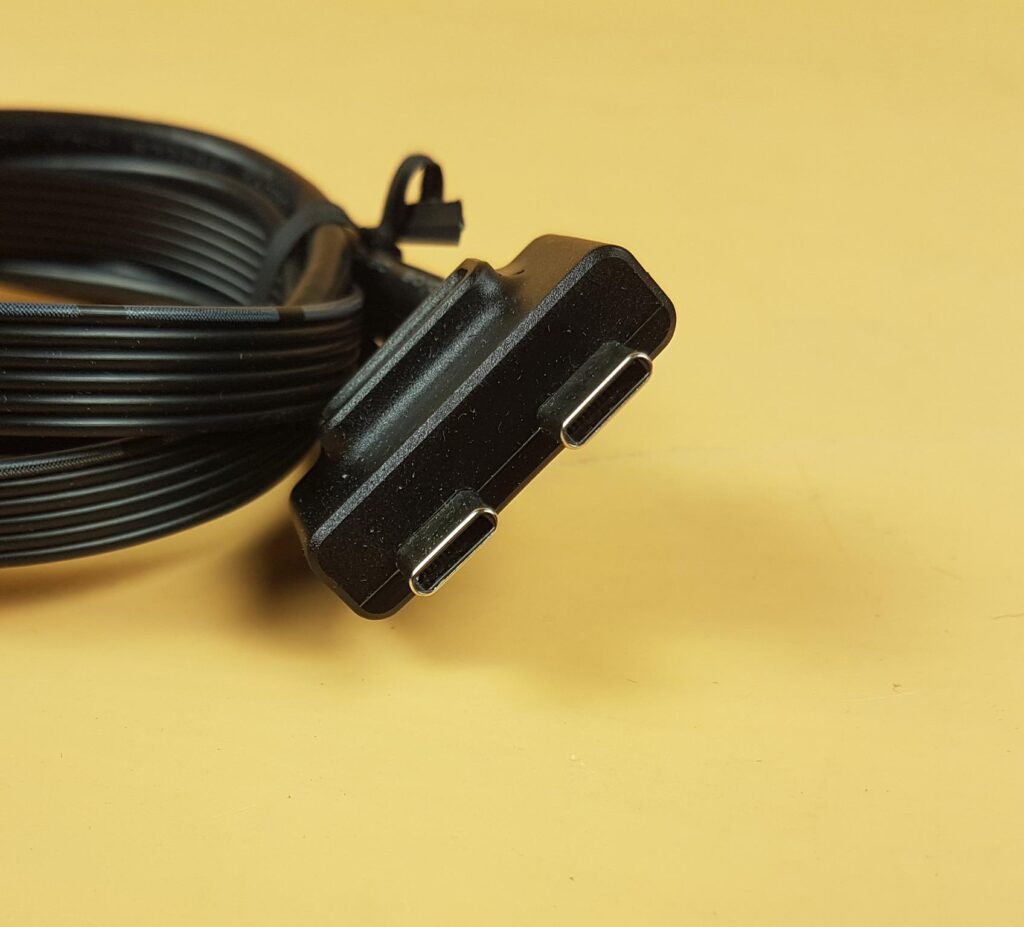
The Nexus Link cable has a dual Type-C ports on one end. This end is connected to the radiator as I will show in the next section.
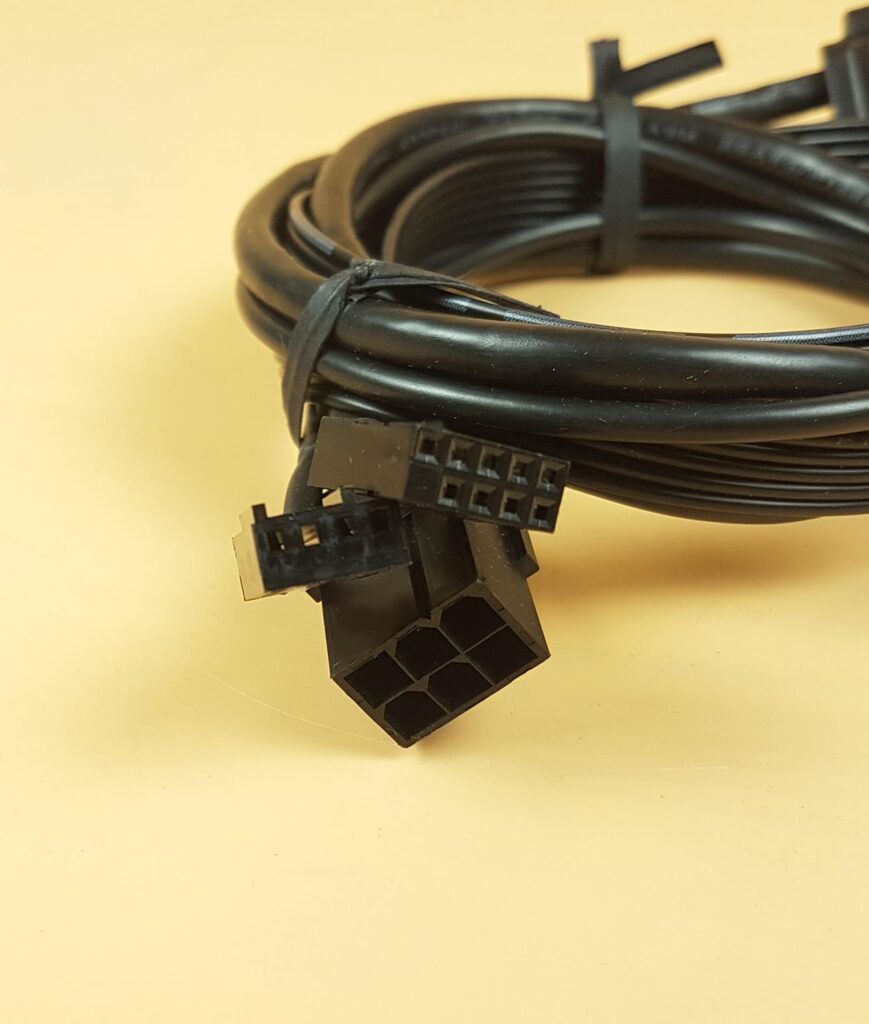
The other end of the same cable has following connectors:
- 1x 6-pin PEG/PCIe Connector
- 1x 9-pin USB 2.0 Connector
- 1x 4-pin PWM Connector [Shows the Pump speed only in Motherboard mode]
The maximum power draw is 180W depending on the number of Nexus devices. A total of 18 devices can be connected using a channel. This device has two channels provided via Type-C and Type-M. Please keep in mind that 6-pin PCIe connector can provide 75W power.
Closer Look
It is time to take a closer look at the components starting with the radiator itself.
RADIATOR
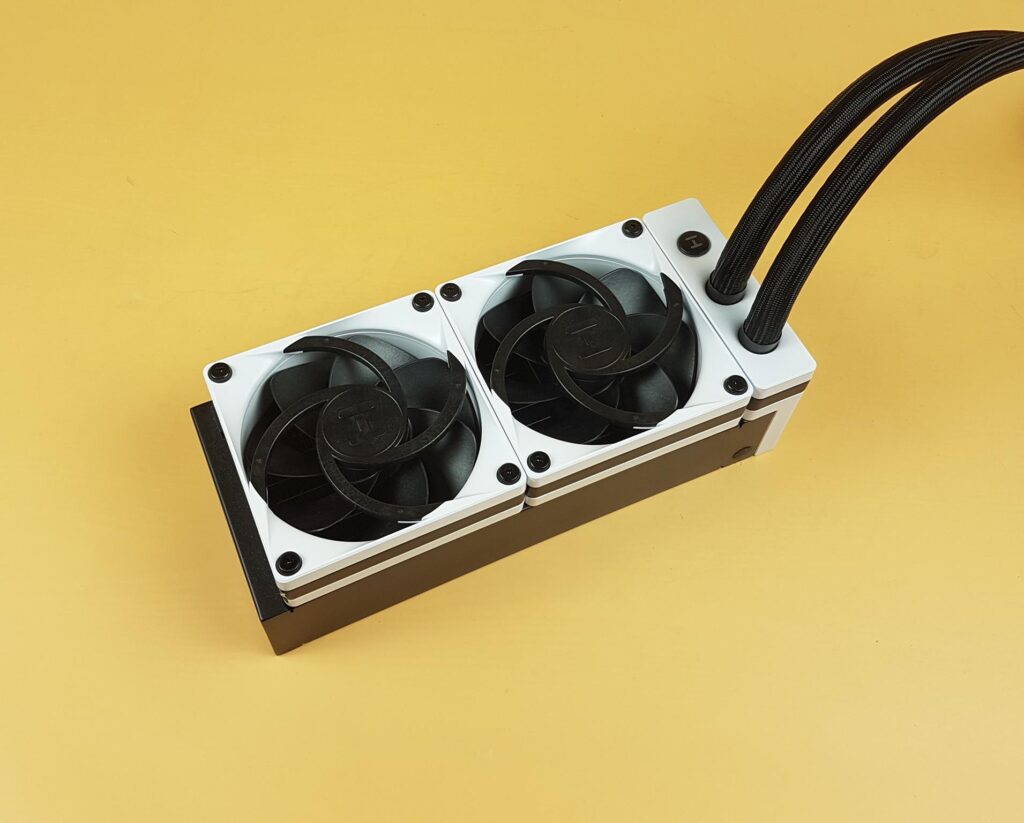
2x PF12 32mm thick fans come pre-installed in a pull configuration. This stock position implies that this cooler is intended for HYTE Y60 and Y70 PC Cases on the side as an intake. Anyhow, this is my assumption. You can use this cooler in any configuration as long as your PC Case can support this cooler.
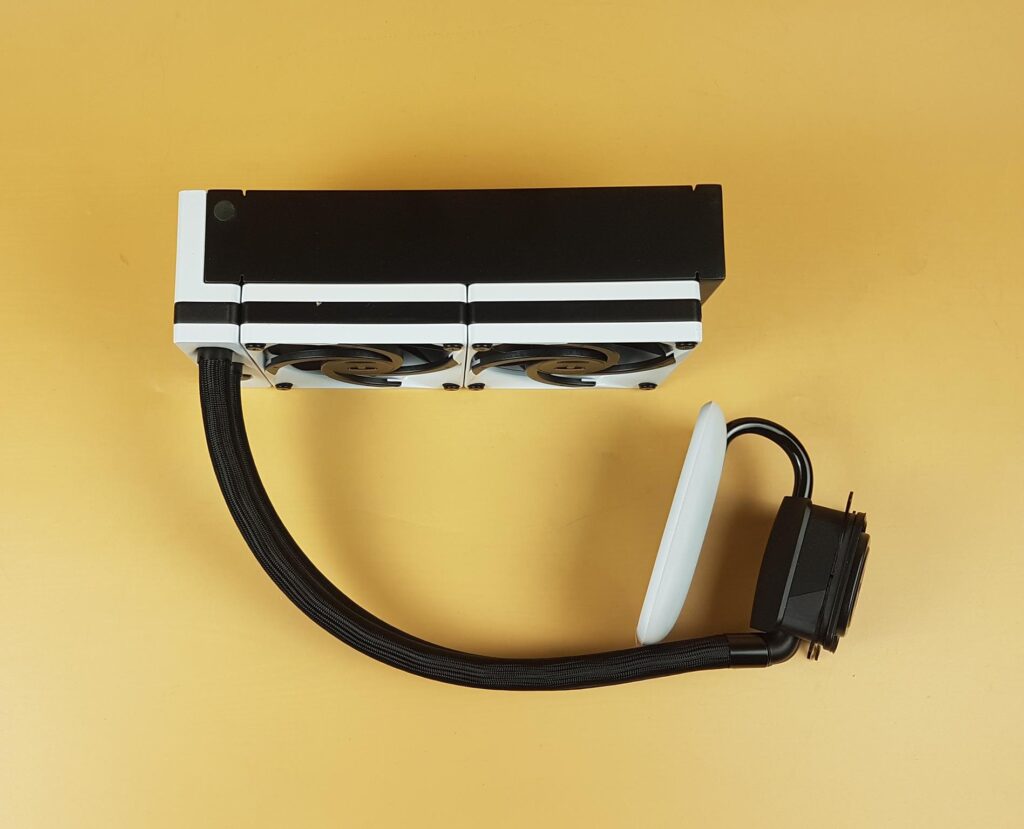
You can see that there is no cable what so ever anywhere on the cooler. Even the fans don’t have cables. Everything is integrated and pre-routed using Nexus Link concept design. The connection between the IPS LCD display and the main link is done via hidden cables routed under the tube sleeves. We have as clean a unit as possible and HYTE has my appreciation for that. This would come in handy for the backplug motherboard and builds in particular. The white and black contrast is popping the color scheme quite well.
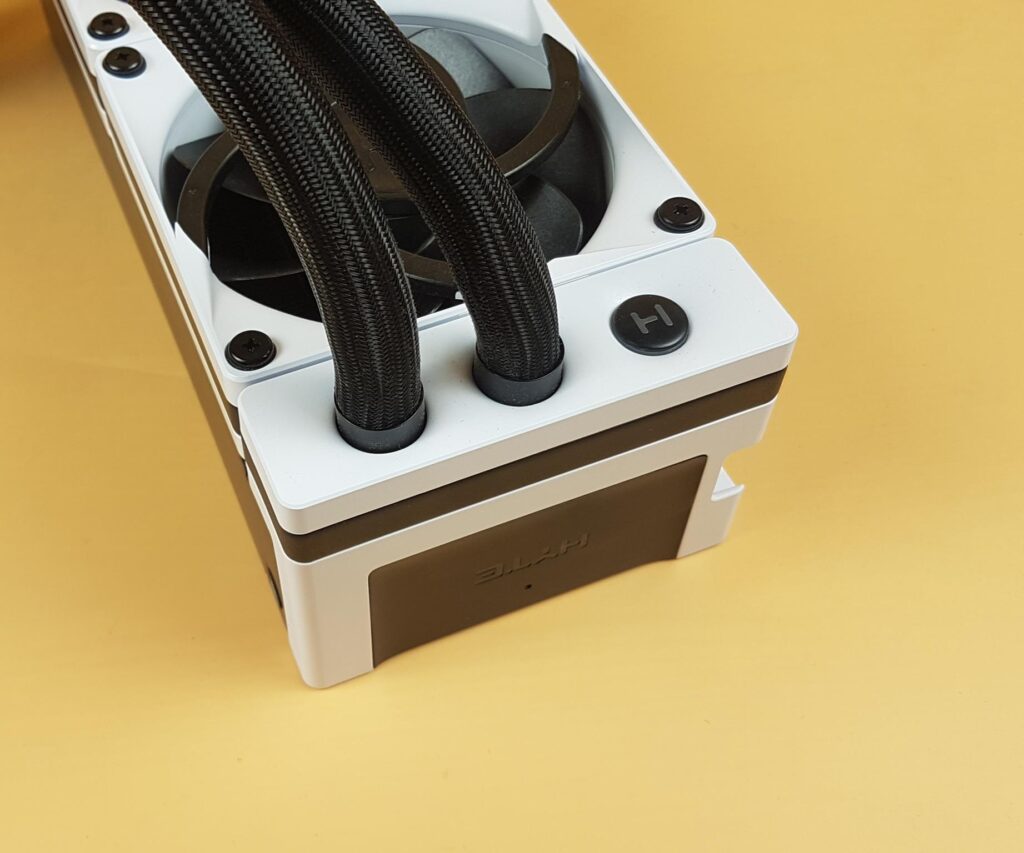
I am showing the tube side of the radiator. HYTE has used CIIR material with nylon sleeves for the tubes. The tube length is 400mm. There is a HYTE branded cover that is backlit as well. The tubes are wider than the standard AIO.
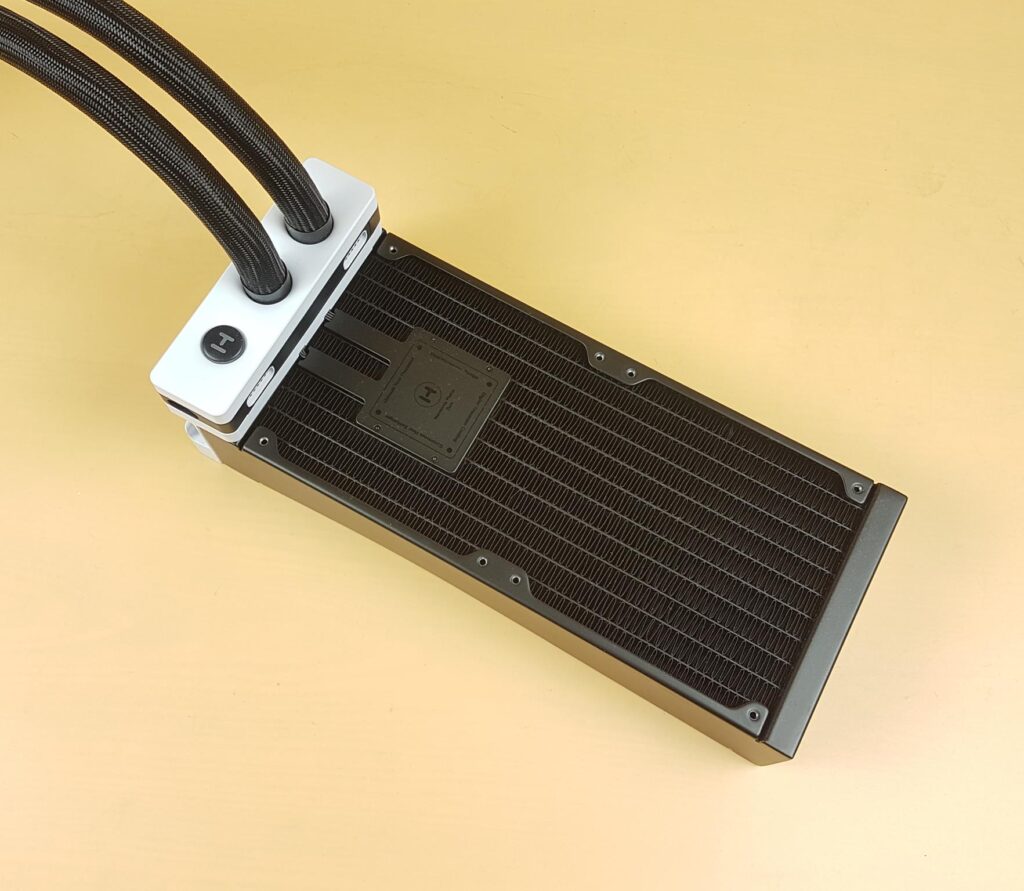
I have removed the fans and showing the radiator. You can see that the pumps are integrated into the radiator. Yes, you read that correct. This unit has two pumps called dual-pump design. The radiator has a dimension of 288x120x52mm (LxWxH). 52mm is a thickness of the radiator unit itself which is quite impressive. This unit has 14 FPI count and 10 channels for the coolant flow.
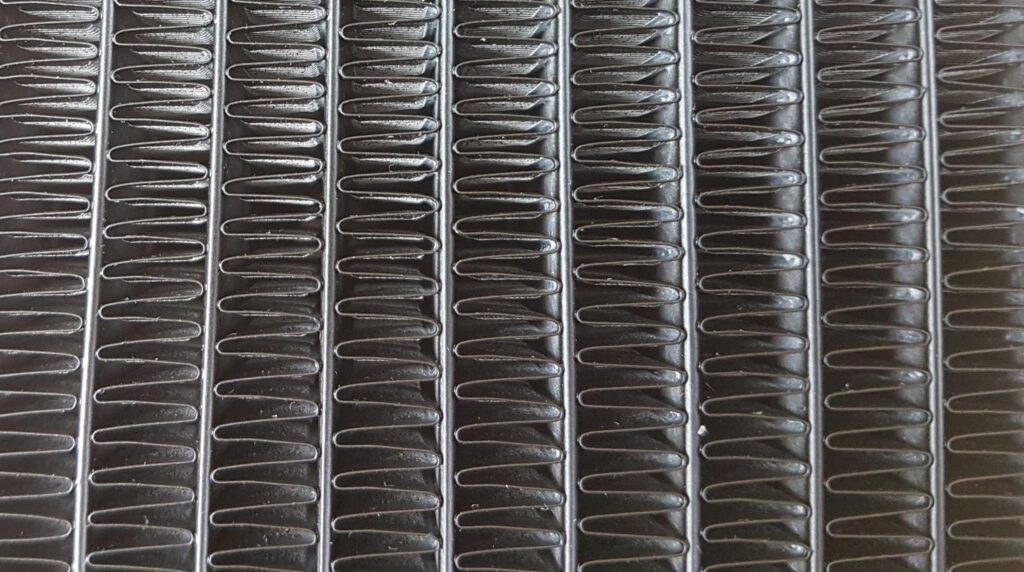
I am showing a close view of the fin stack. HYTE has done a fine job with fin stacking since there is no bend or broken fin anywhere.
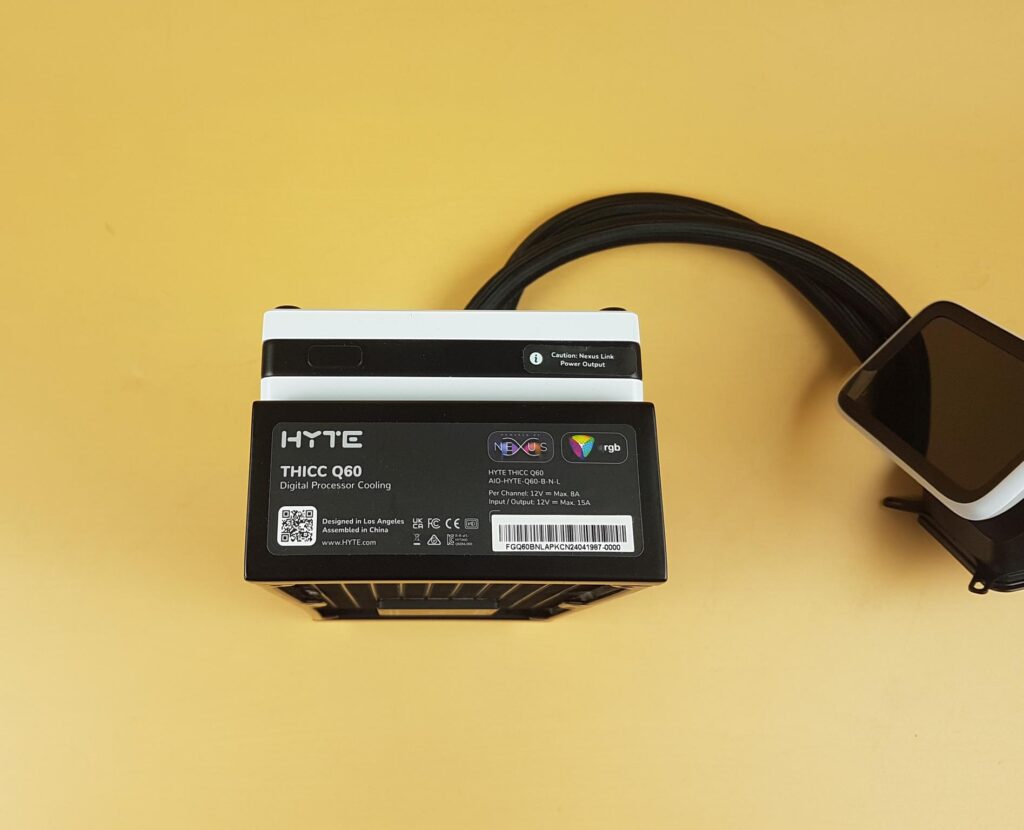
There is a label on one end of the radiator assembly showing the power rating of the channels. The unit is designed in USA and assembled in China. There is a cover over a port labeled Nexus Link Power Output. This port is on a FP12 fan.
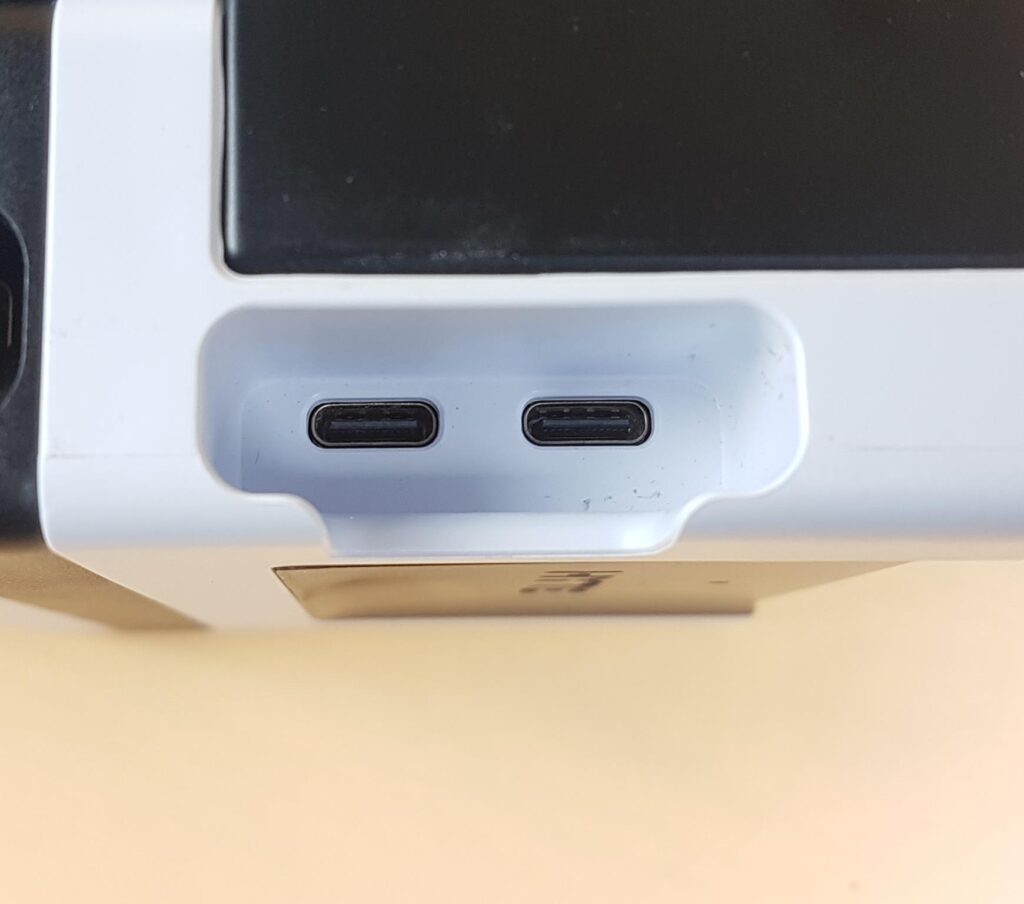
The side of the radiator has a dual USB Type-C ports to which the bundled Nexus Link cable is connected. What is not visible is another USB-C port above the Type-C ports.
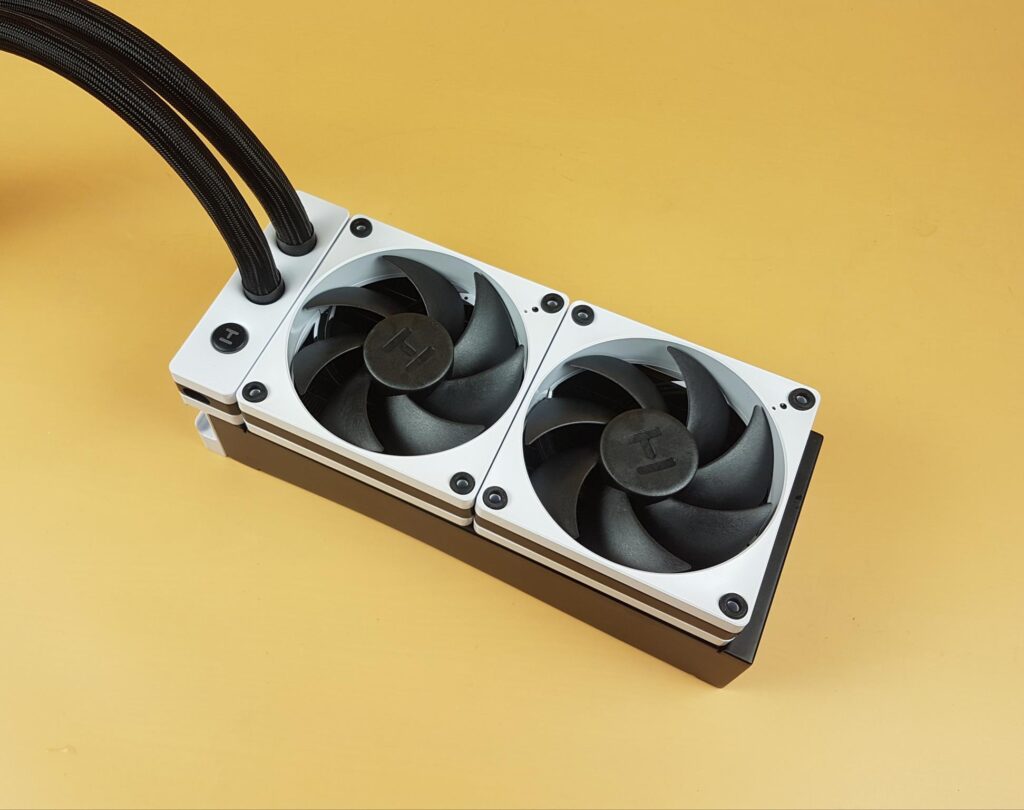
Here, I have done it. You can install fans in any direction however you want.
Pump
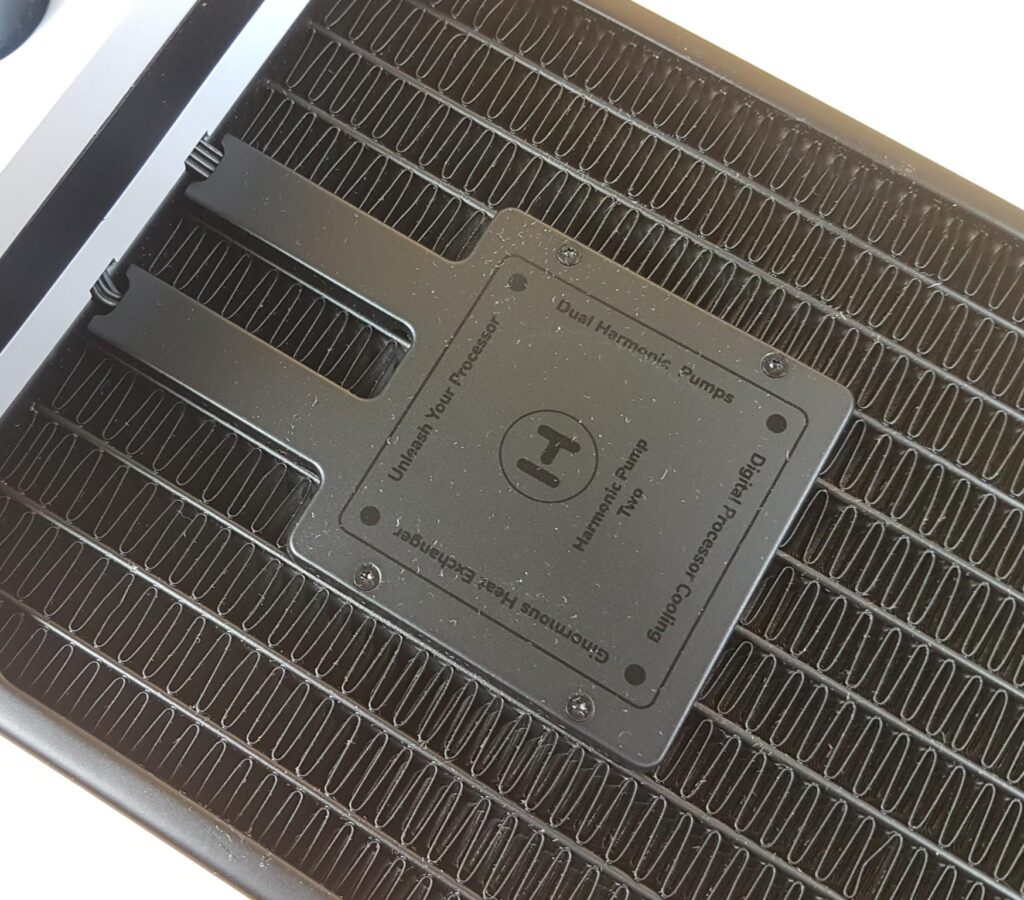
Since we are at it, HYTE has used dual harmonic pumps which are integrated into the radiator assembly. These pumps are rated for 2000 to 4500 RPM. They use ceramic bearing with a 24mm diameter impeller. HYTE has covered the cable routing coming out from the pumps and going towards the rear of the radiator assembly. The attention to the design is too good.
Block and Display

Since the pump is relocated to the radiator, the main housing is slim. There is a magnetic cover over the copper base. Intel mounting brackets come pre-installed.
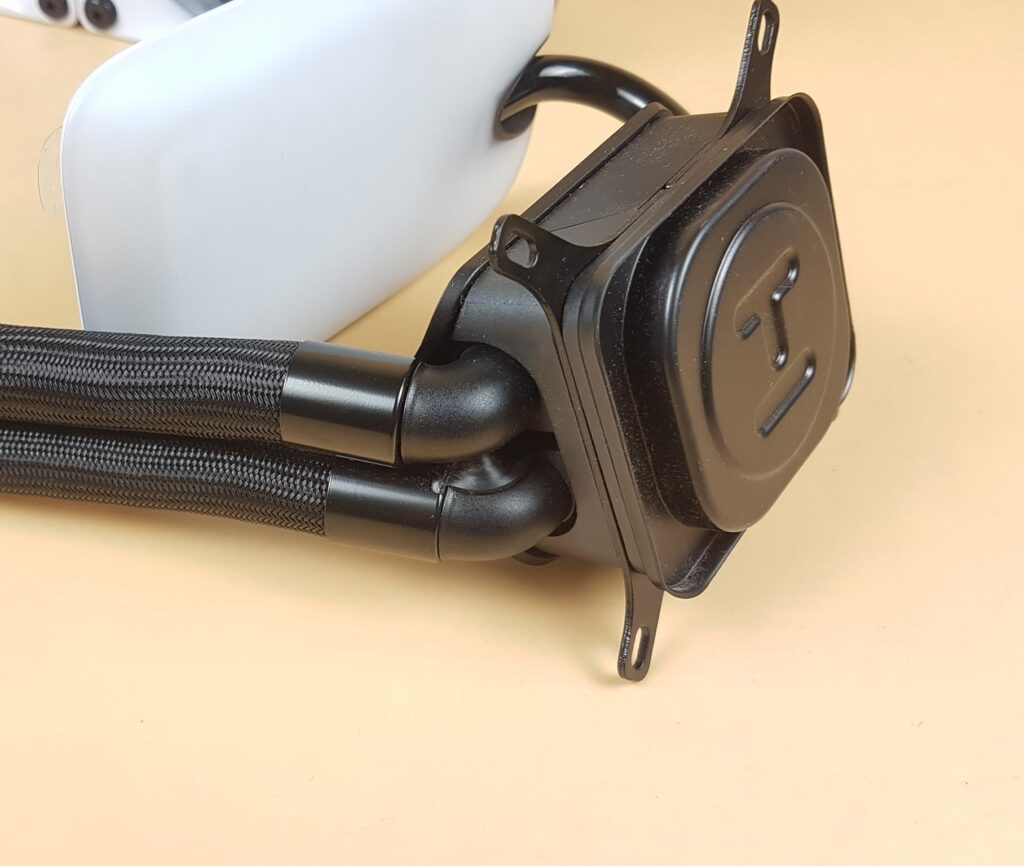
There are what seems to be elbow fittings providing a near 90ᵒ angle connection between the tube and fittings. You can’t find a cable there as well.
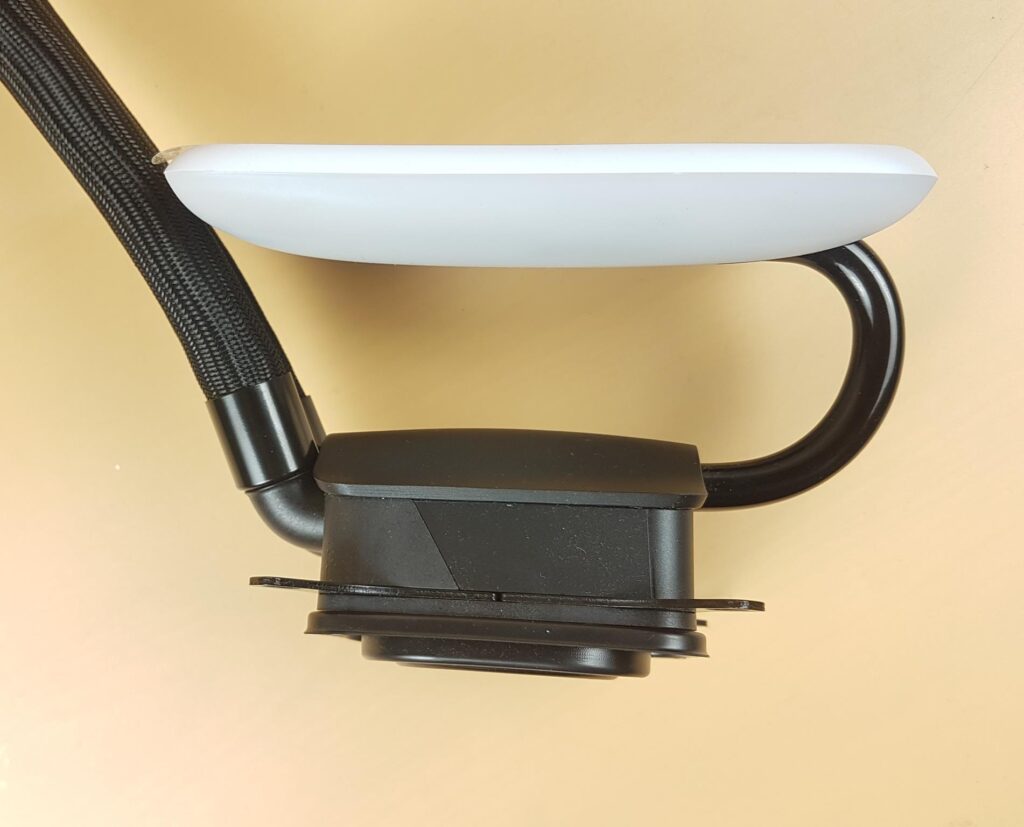
I am showing a side view of the main housing. There is a slope design over the top of this housing. You can also spot that the backside of the IPS LCD screen is a big diffuser for a vivid A-RGB lighting effect.
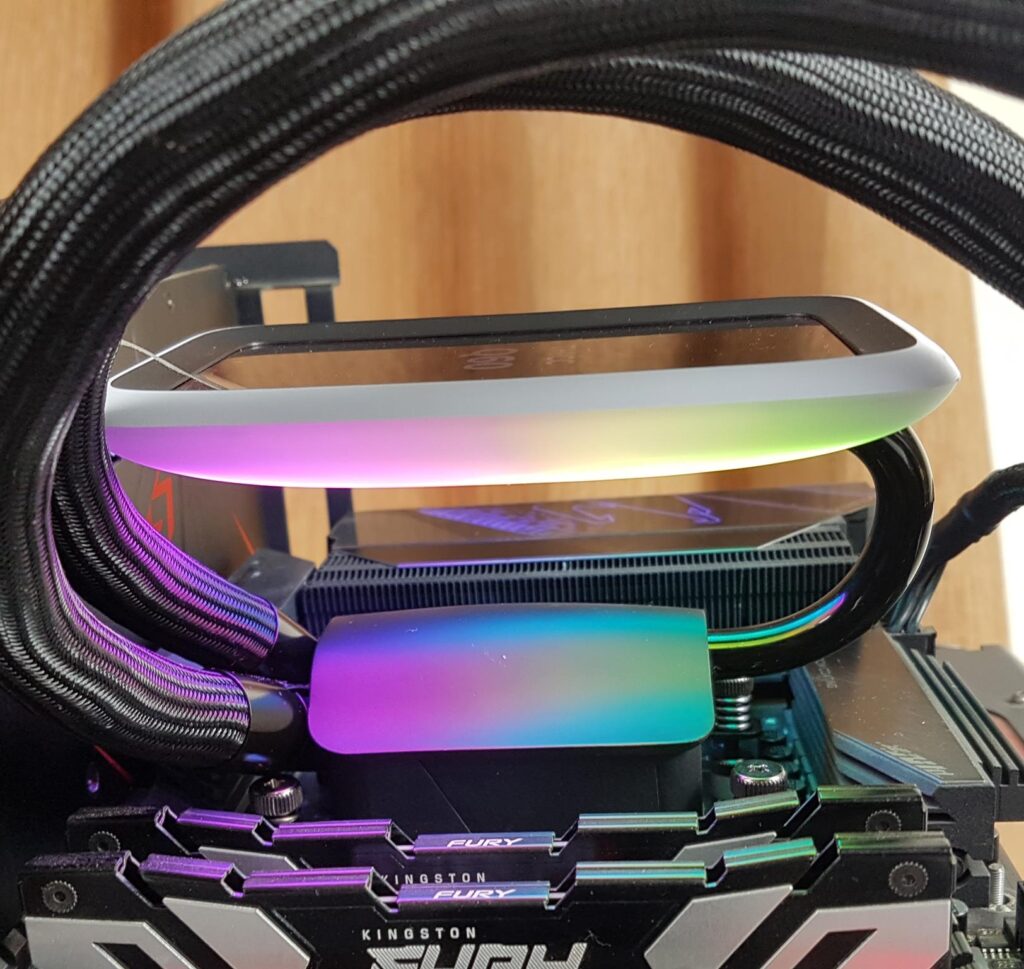
The picture shows the underside A-RGB lighting effect. HYTE was taking advantage of every corner of this unit to provide a next-level aesthetics and performance.
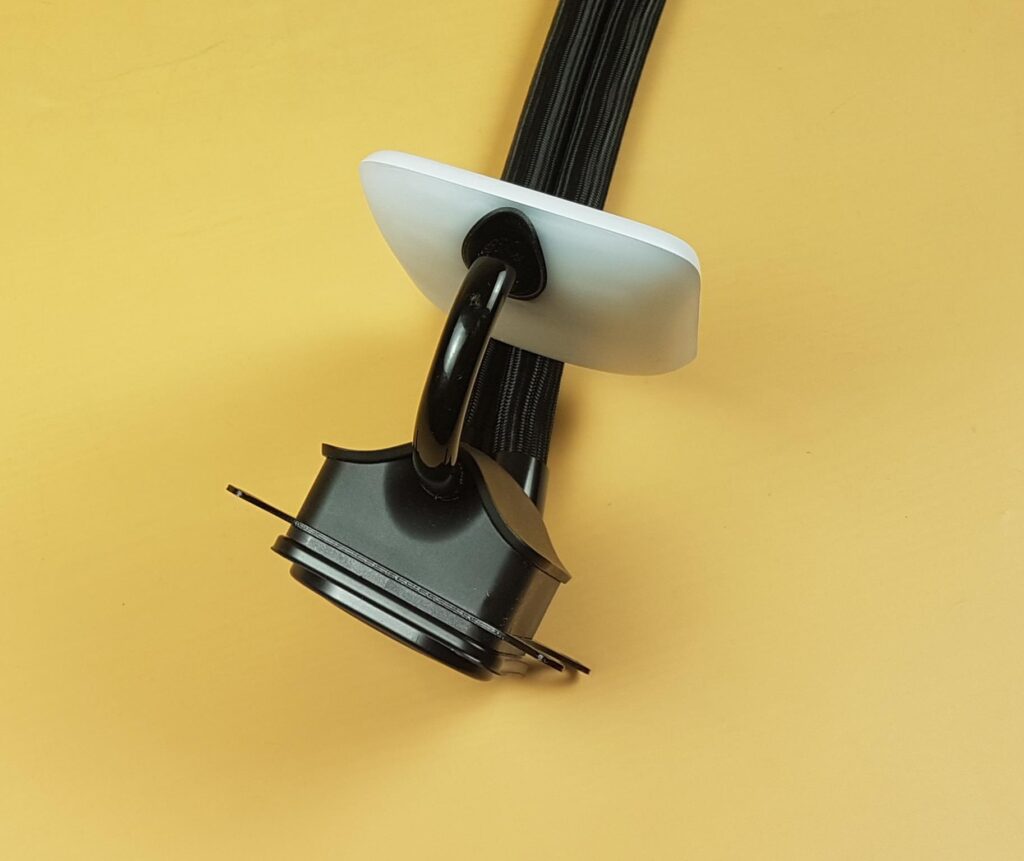
This angle provides a better view of the housing. This is a hut style. HYTE has Double-Hinged Floating Spout connection between the display screen and the main housing. This provides a 90ᵒ swivel rotation to the screen. Be careful when handling the unit.
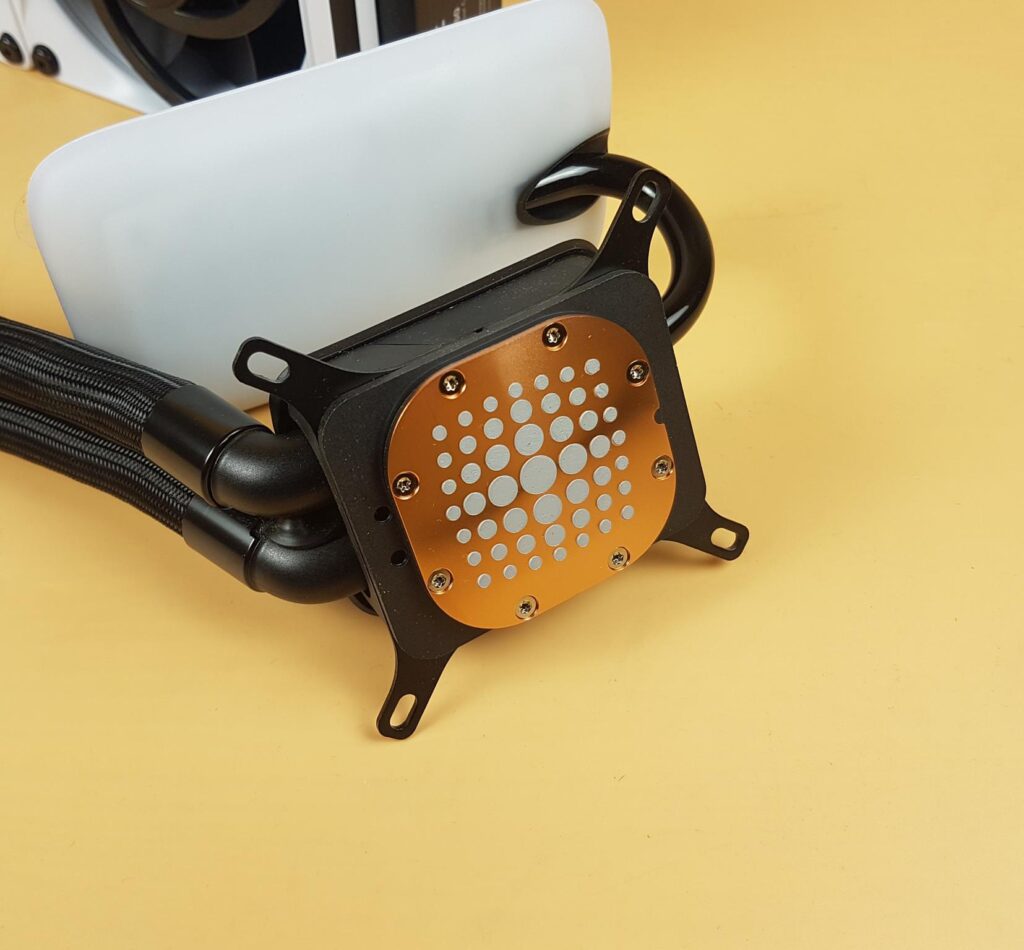
The copper base measures 56x56x1.5mm. It comes with a pre-applied thermal paste. HYTE did not include a thermal paste tube which they should provide given the high price tag and to make this unit a complete comprehensive package.

Now, I am showing the action center of this unit. It is a 5” IPS panel. The total height of the display unit and the housing including the pivot connection is 105mm. This screen has 720 x 1280 resolution, with a 60Hz refresh rate, and 300 nits of brightness for an incredibly crisp and smooth visual experience. It uses 42-Pixel qRGB Array.
HYTE has used a quad-core 64-bit, ARM Cortex processor rated for 1.3GHz using a 2GB DDR RAM operating at 2666MT/s. HYTE has also provided a 32GB on-board storage (eMMC). The graphics engine is rated for 500MHz speed using 32-bit Cortex M4.
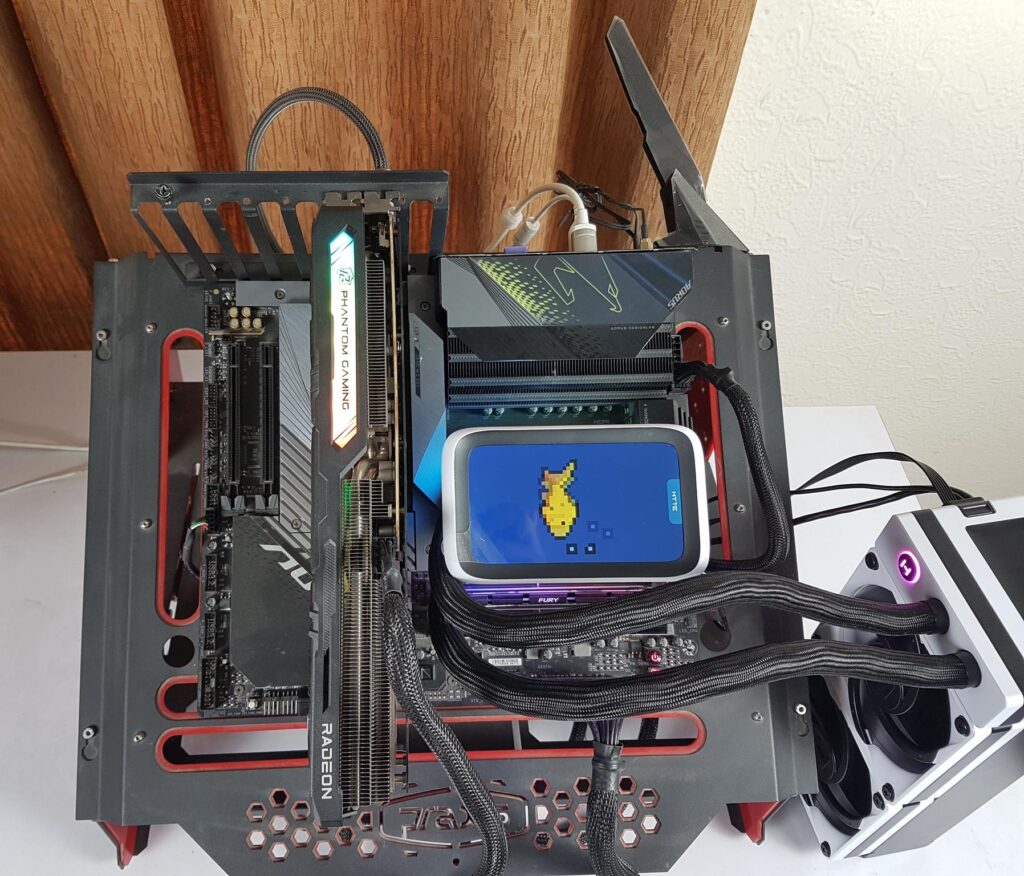
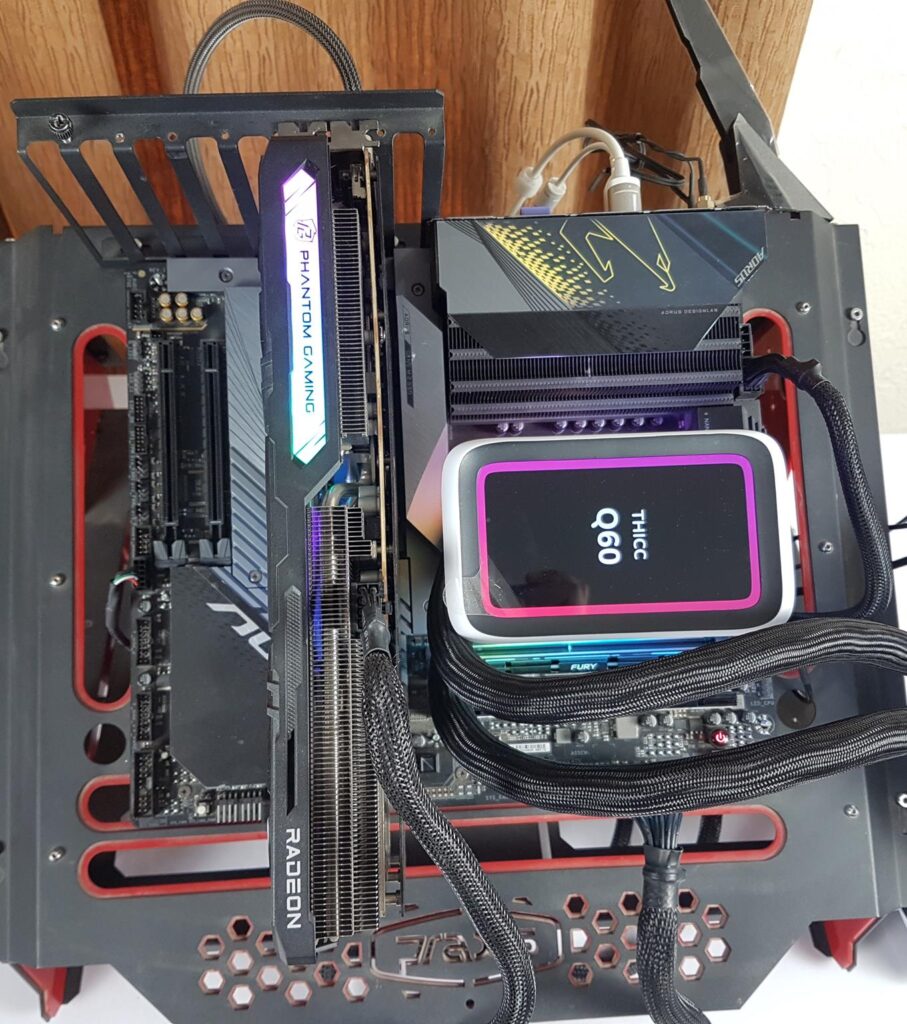
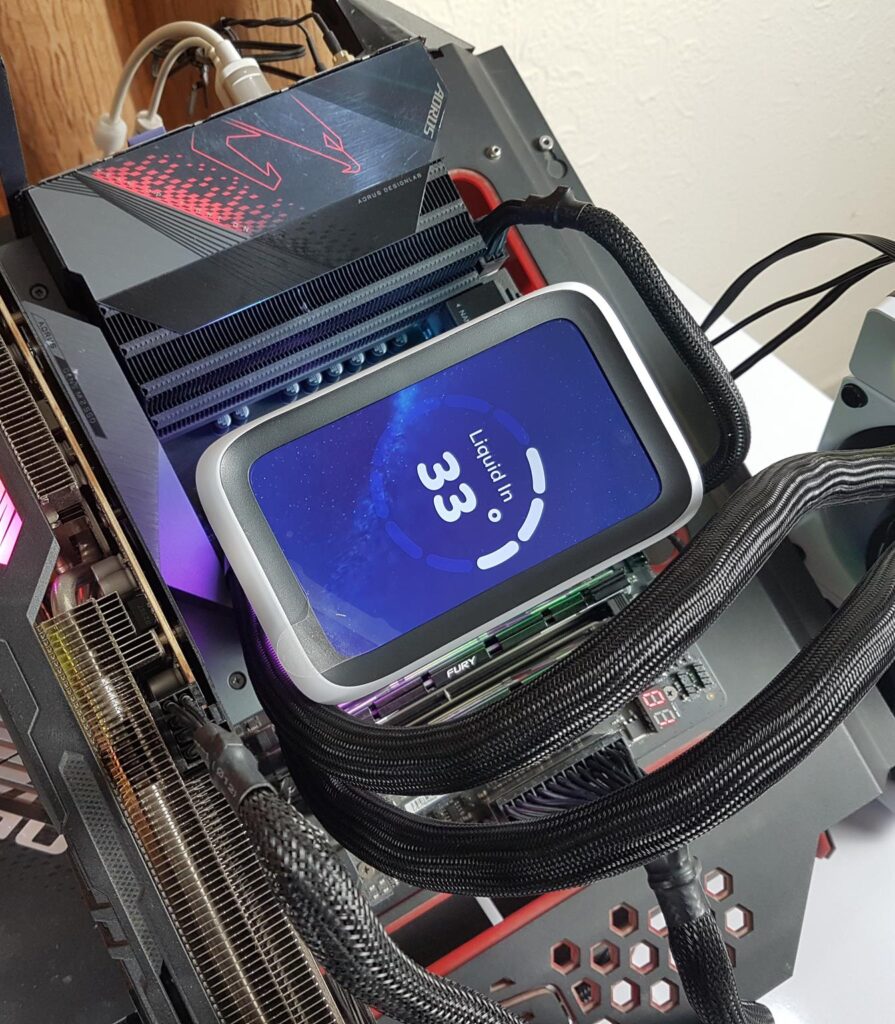
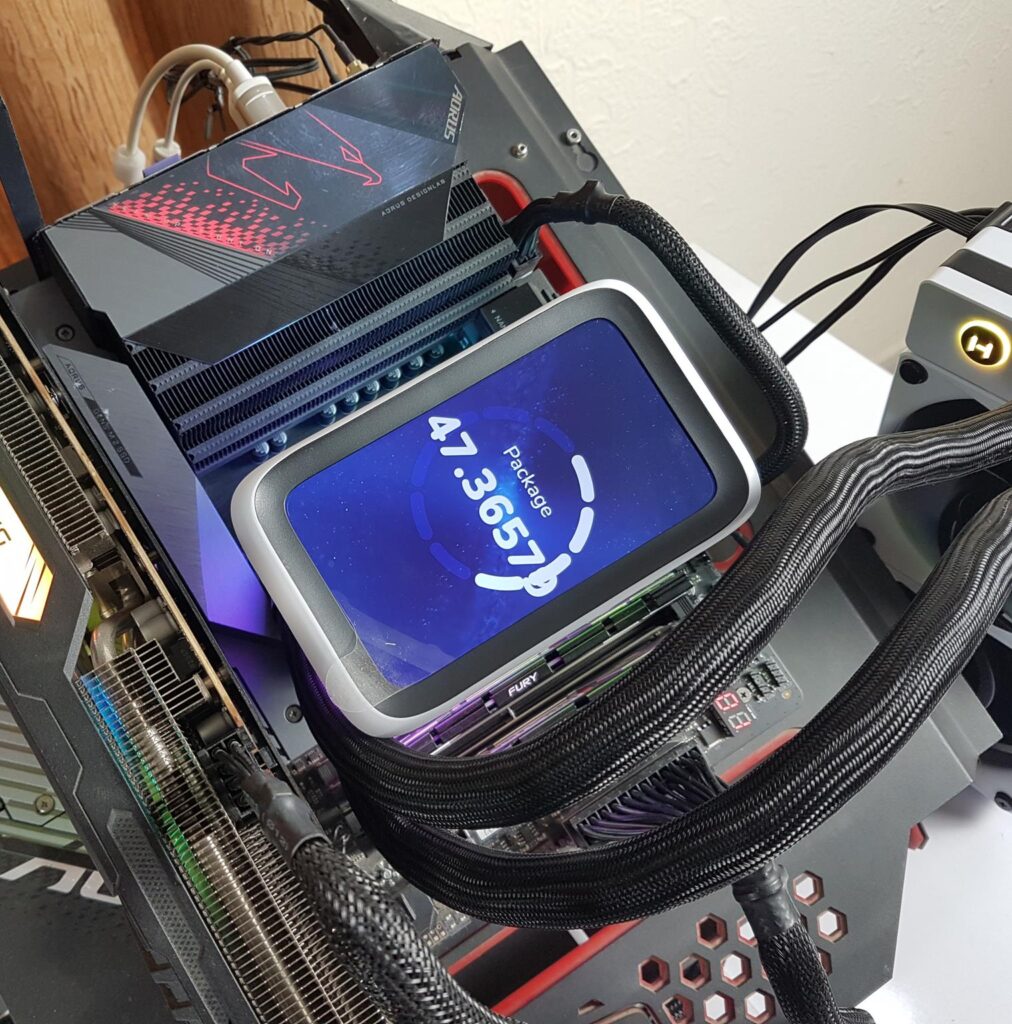

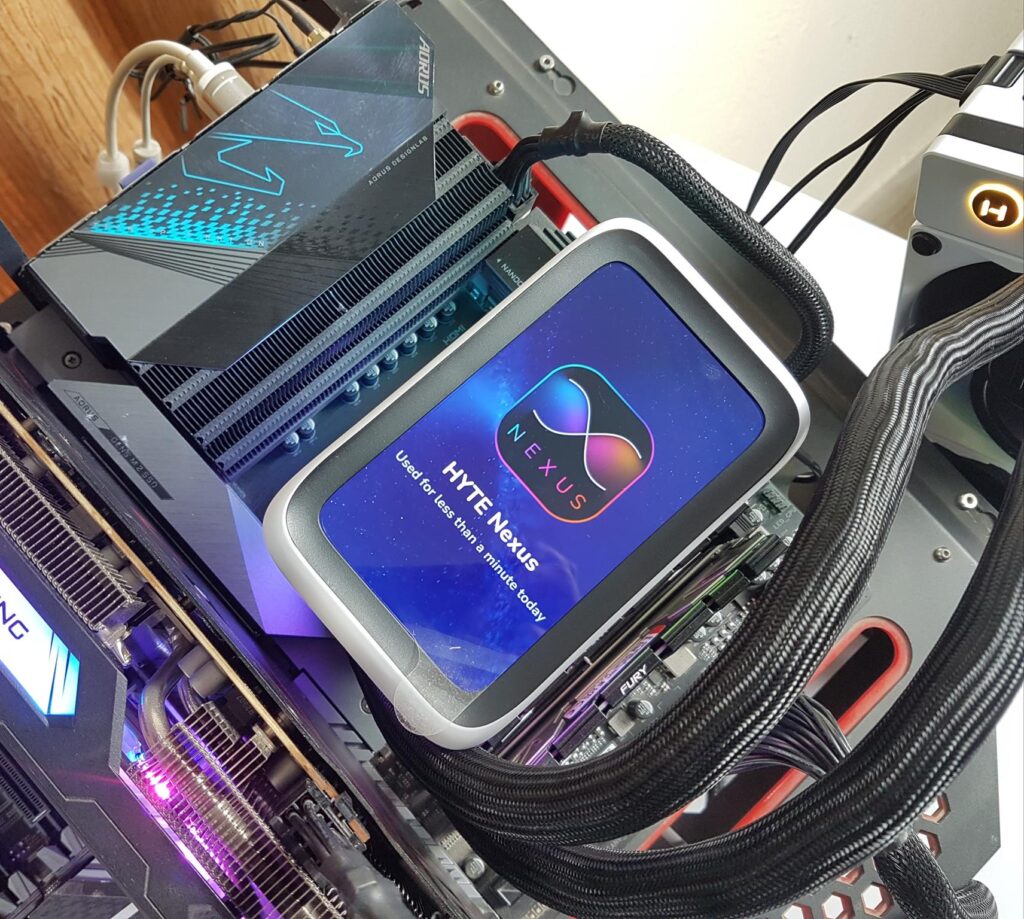
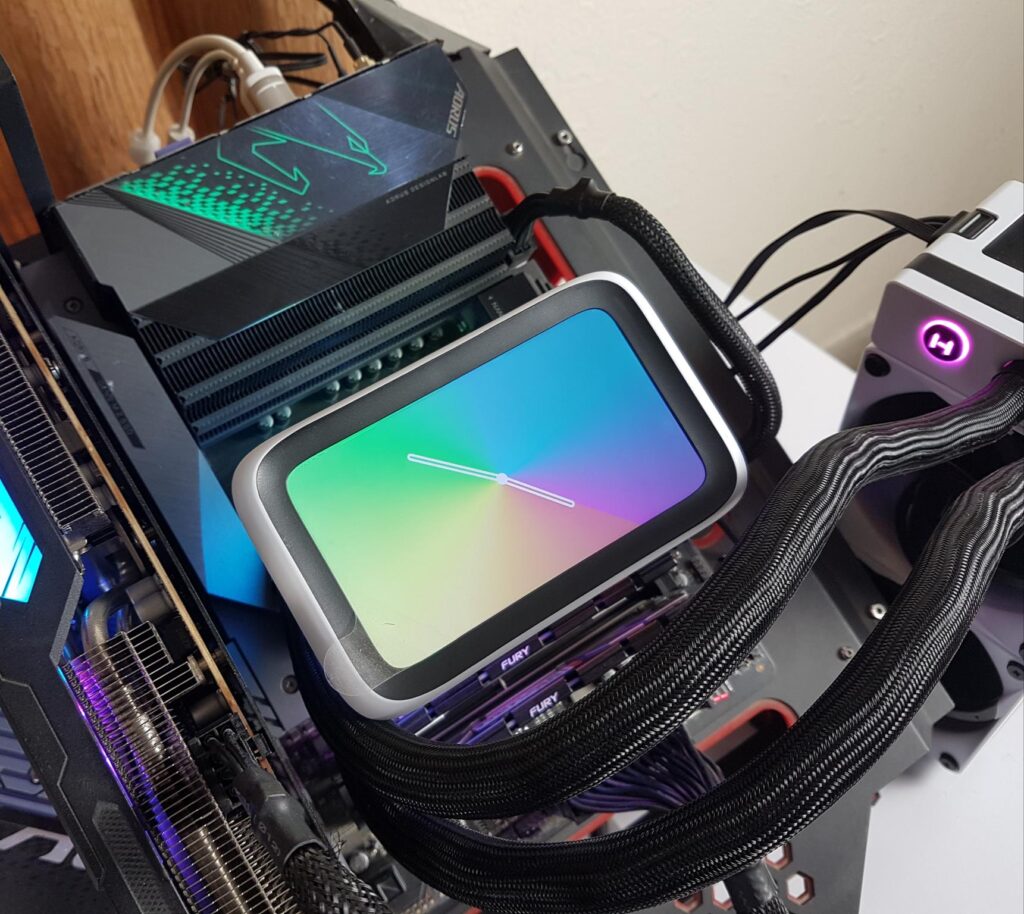
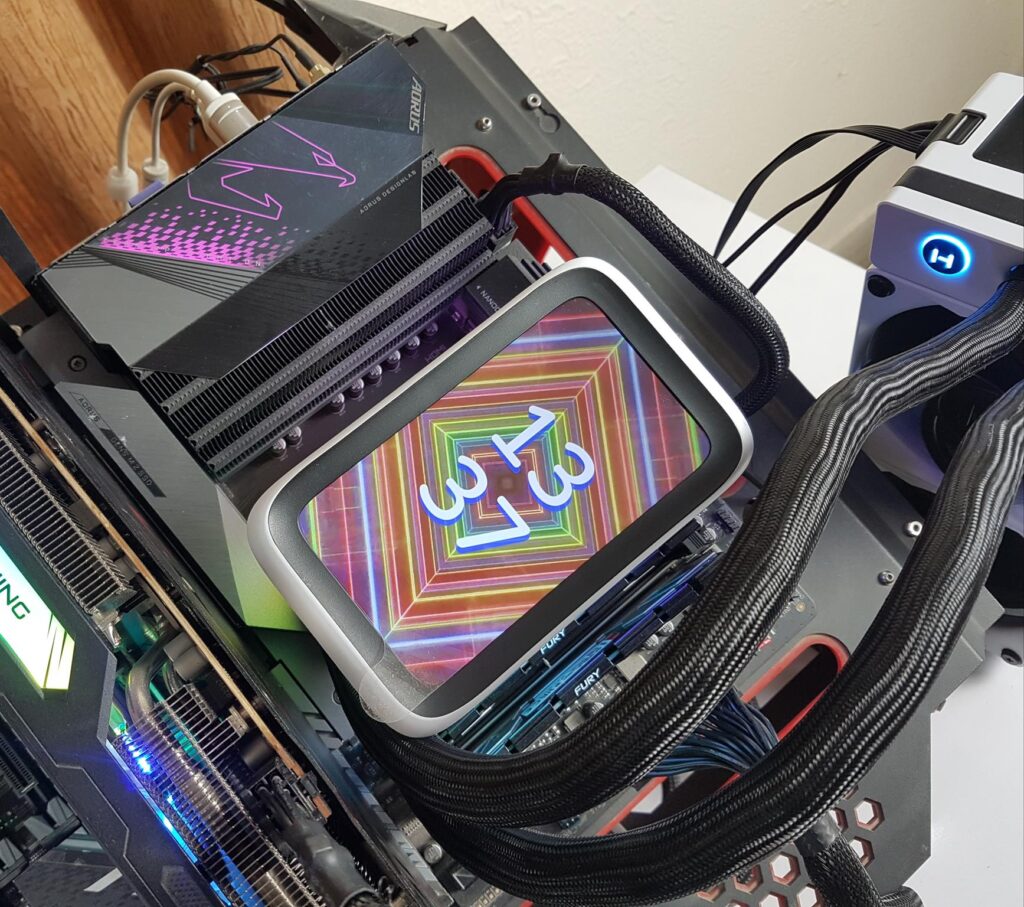
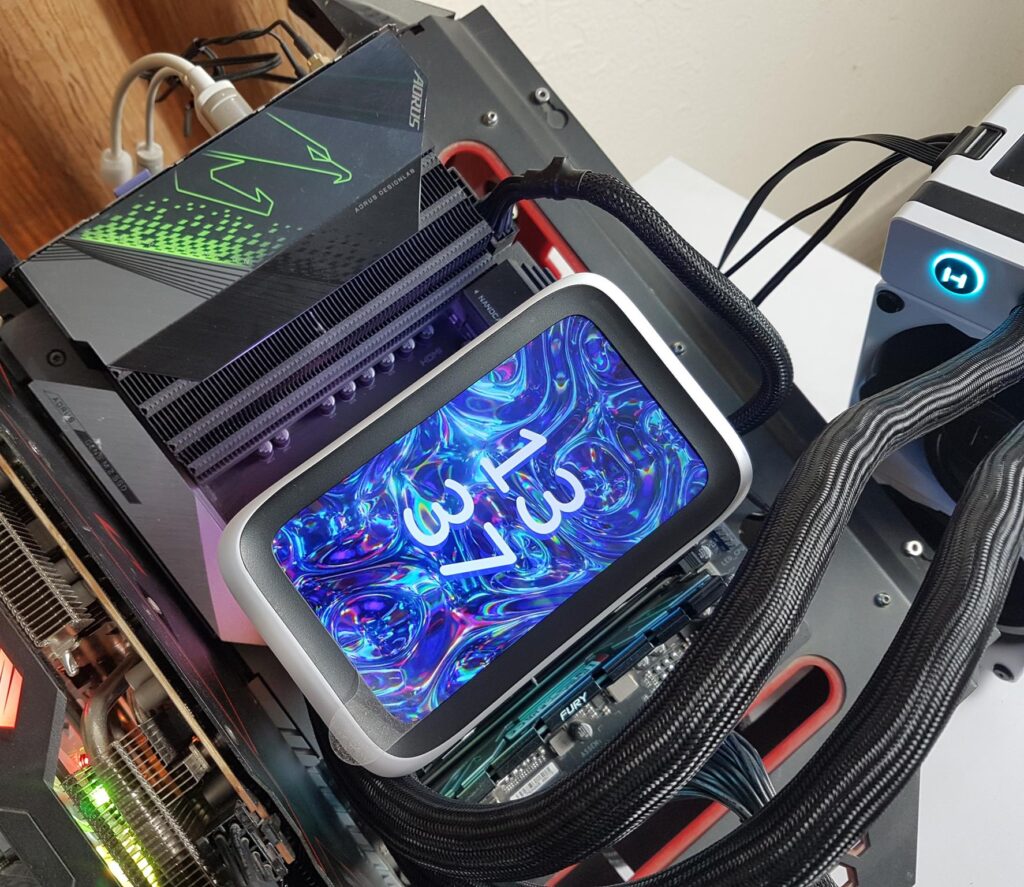
The above pictures show some of the display options that you can display on the screen using Nexus Software. The ability to play multimedia is also there along with a live animation as a background. There is so much that you can do with this screen. It is almost a mobile phone without a touch control!
FAN
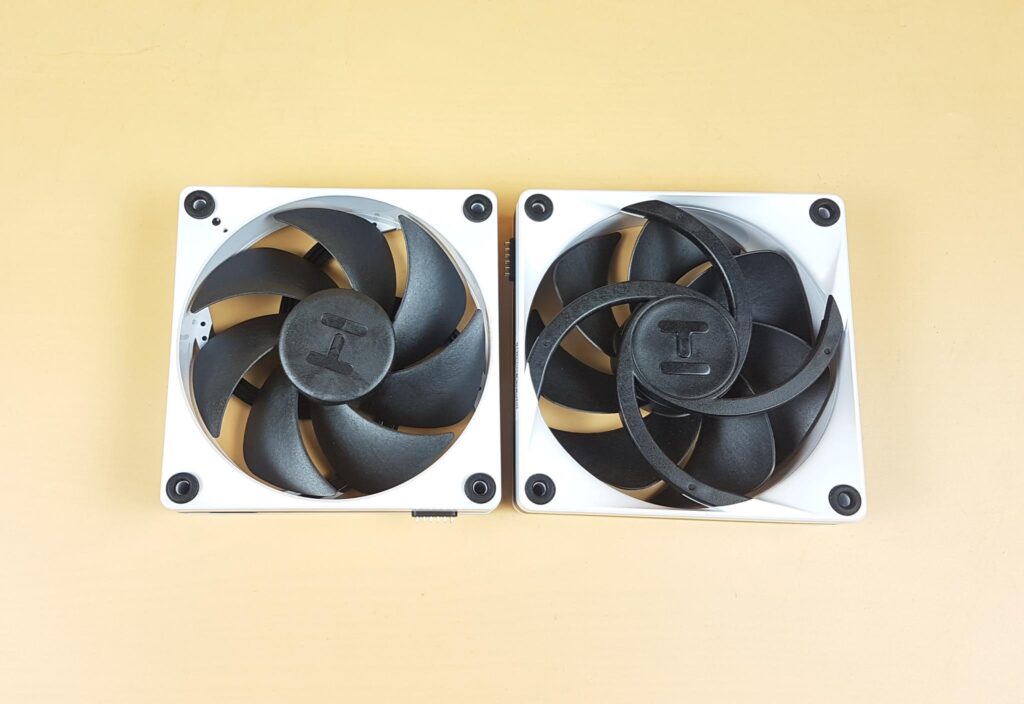
HYTE is using 32mm thick 120mm fans named FP12 with this unit. These fans are rated for a 3000 RPM speed. They are Nexus powered. In fact, the complete unit is Nexus powered. The frame of these fans is white whereas the blades are black. Each fan has 7x blades. There are black anti-vibration pads on the mounting corners. The frame is made of polycarbonate whereas the blades are made of fiberglass reinforced liquid crystal polymer material. It reminds me of the Noctua NF-A12x25 fans.
The backside of the fans has a 4-arms assembly. These have a wider body. Since these are installed opposite to the blades’ spin direction, the disruption would be low. These arms also have sliding edges.
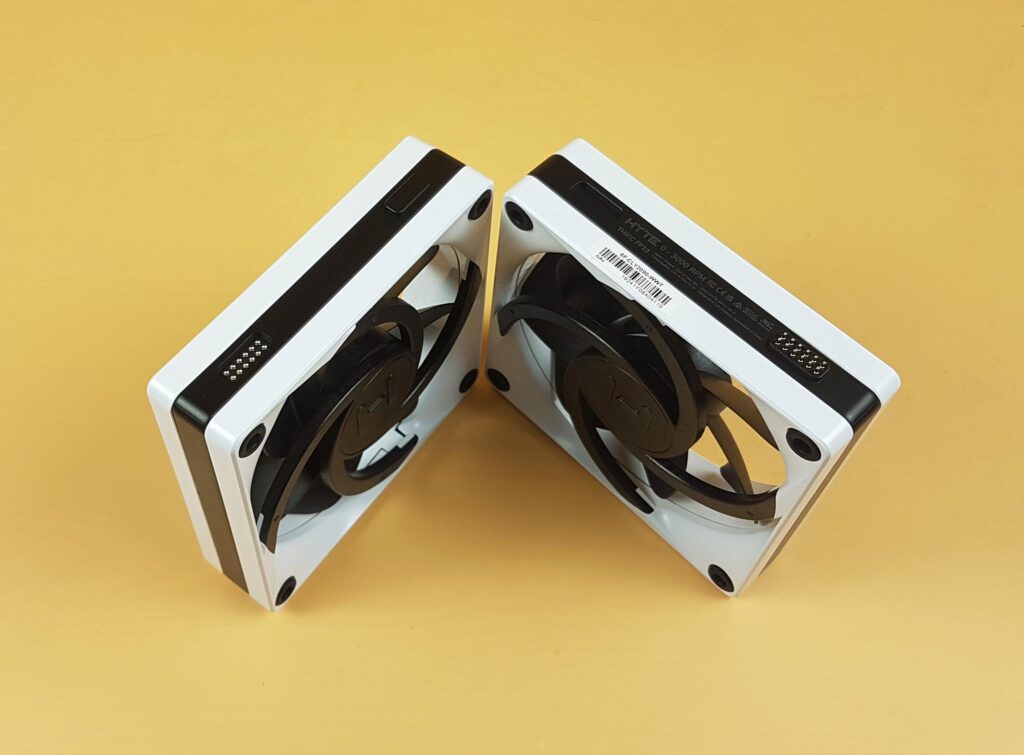
I am showing the sides of these fans. There are 12-pin proprietary connectors on each fan. These are Nexus Power Input and Output connections. The fans are magnetically connected.
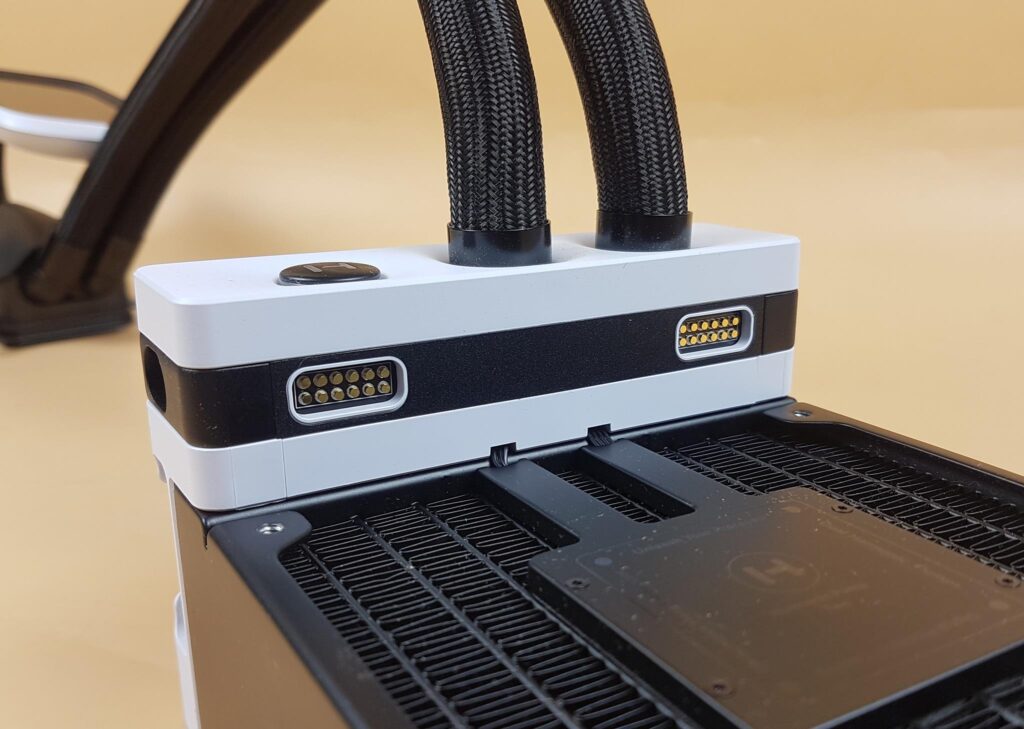
There are two ports on the radiator assembly. The magnetically connected fans are connected to one of these ports. A user can connect up to 34 devices in two channels. Each channel is rated for 8A/12V with a maximum 15A/12V from both channels at a time.
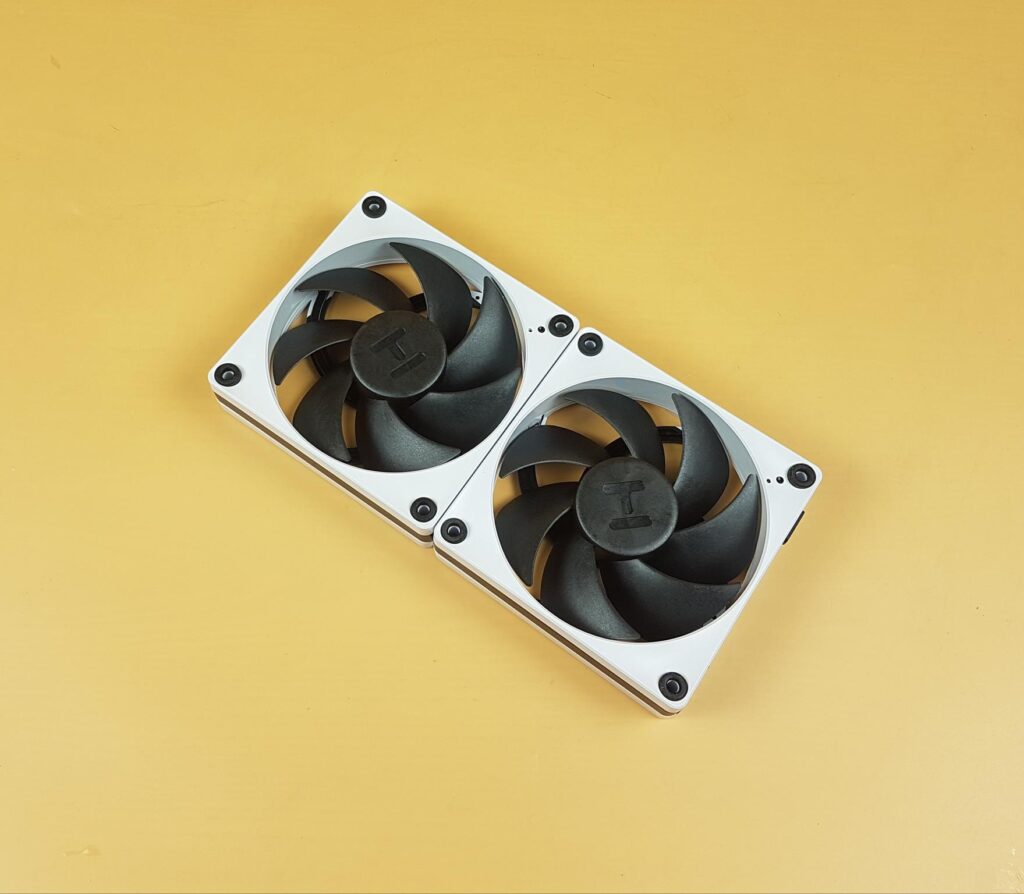
I am showing both fans connected together.
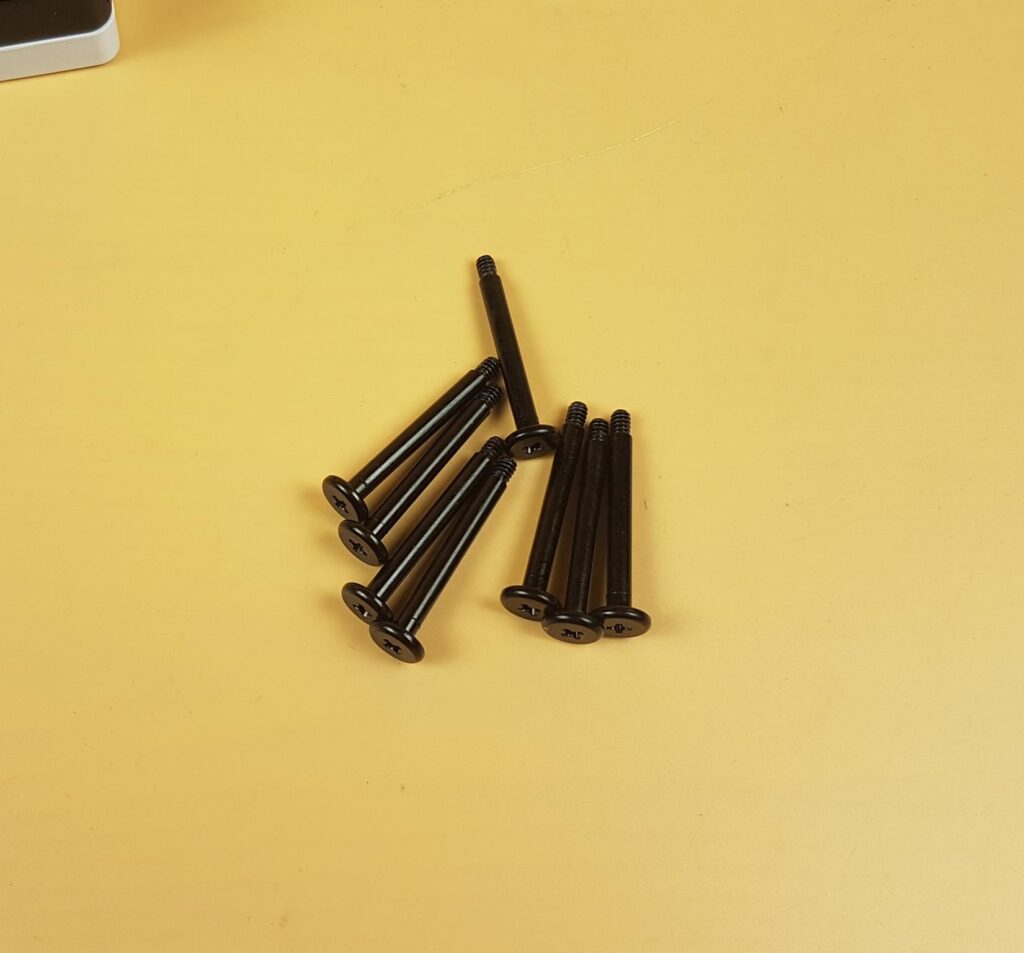
This unit has 8x fan screws.
The salient specifications of these fan are:
| Dimension | 120x120x32mm |
| Speed | 0 to 3000 RPM |
| Airflow | 105.8 CFM |
| Air Pressure | 8.14 mmH₂O |
| Noise Level | <10.0 To 47.3 DBA |
| Bearing | Fluid Dynamic Bearing |
| Control | Nexus Powered |
| Control Interface | Nexus Link Type-M |
Installation
I am not covering the installation. Please refer to the user manual for that. But I would mention any key observation recorded during the installation. I have tested the unit in an open-air test bench. There was no issue concerning the installation on AMD AM5 platform over the GIGABYTE X670E AORUS MASTER motherboard.
Clearance
This unit has an overall dimension of 288x120x84mm. This has a serious concern for the supported PC Case. You can install this unit on the top, side, front or even on the base since the pump is integrated inside the radiator assembly. However, 84mm clearance is required which makes its installation on the top almost impossible.
Nexus Software
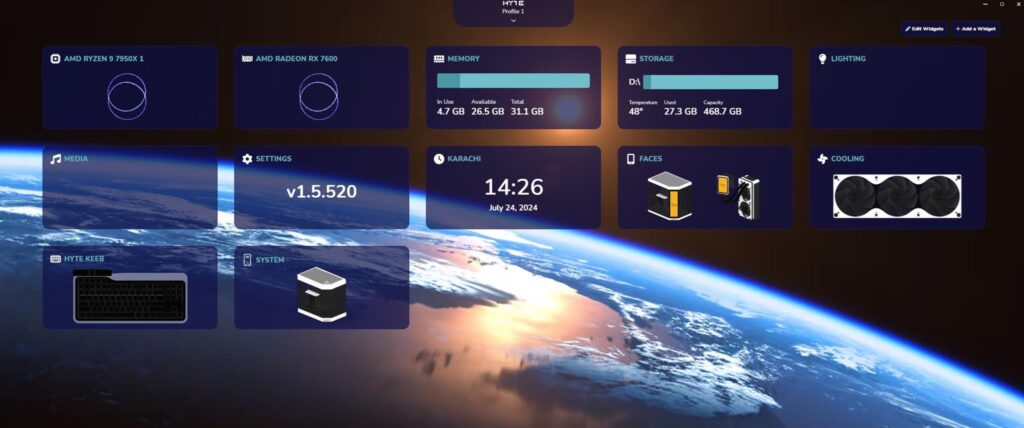
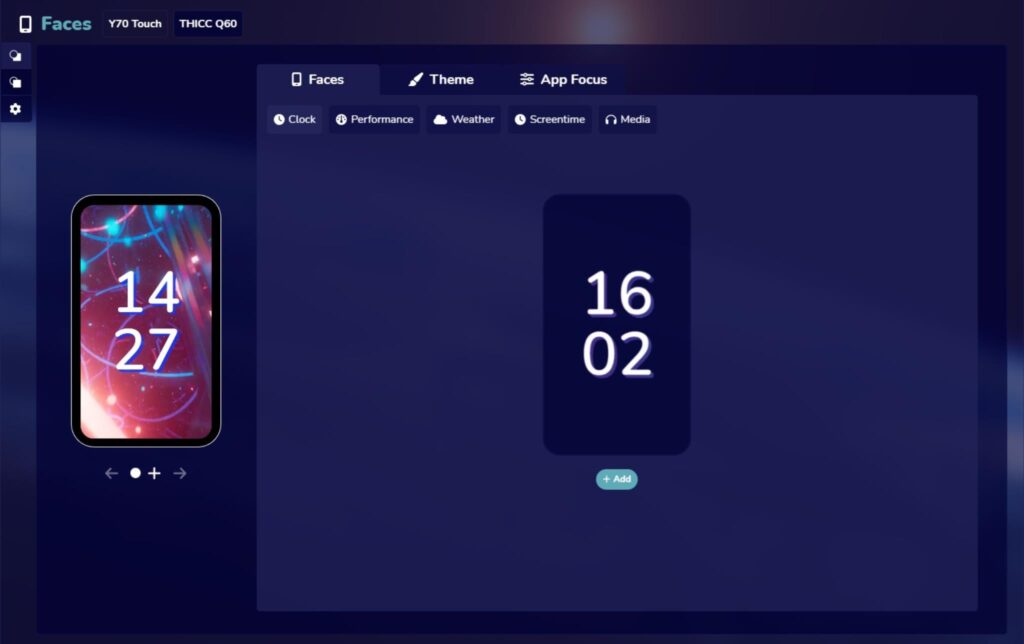
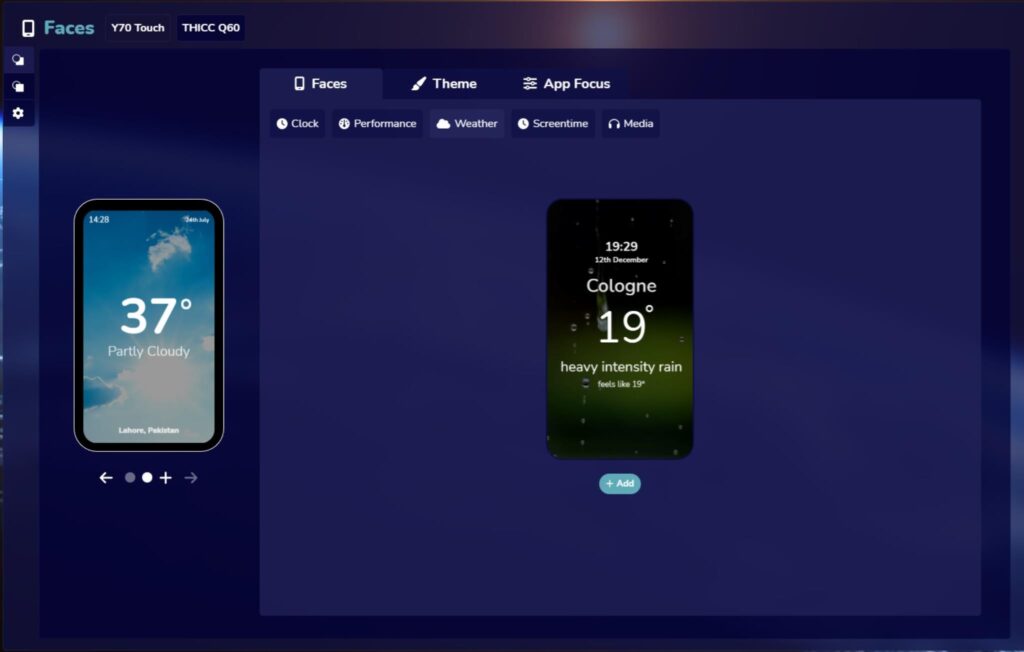
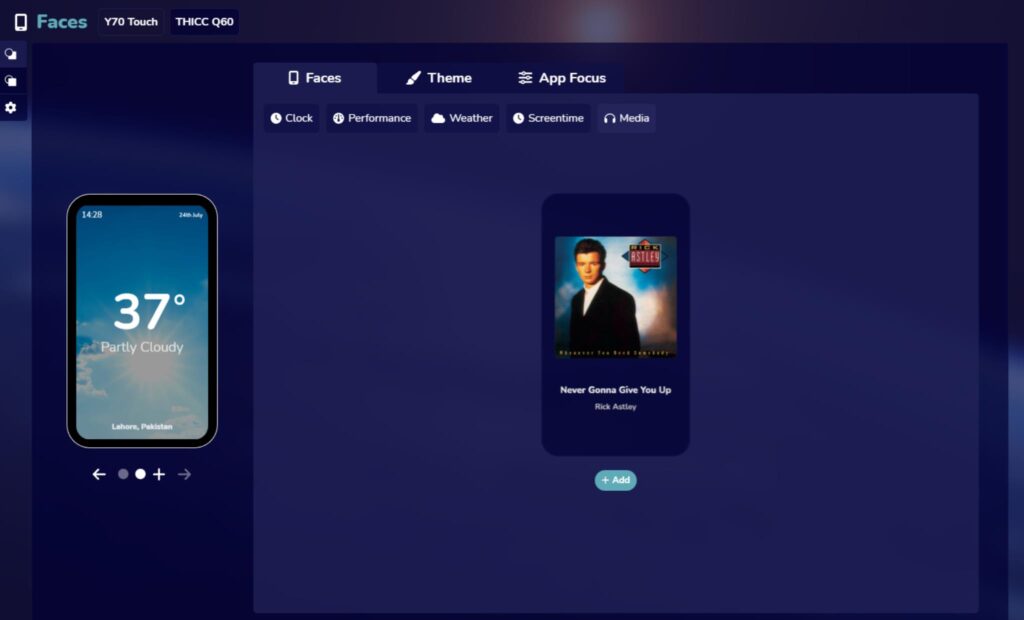

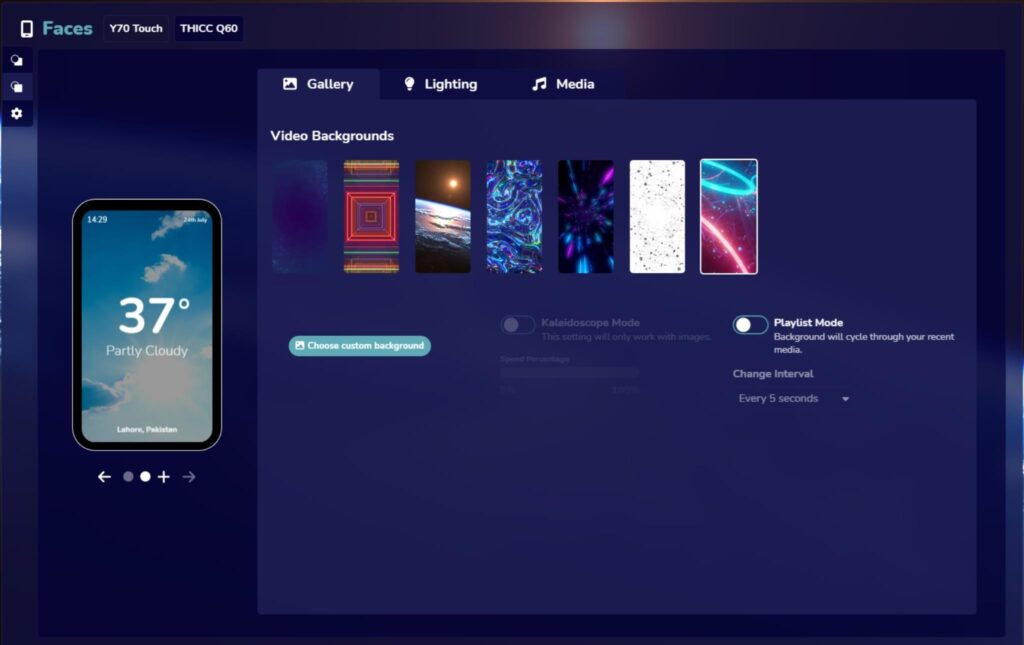
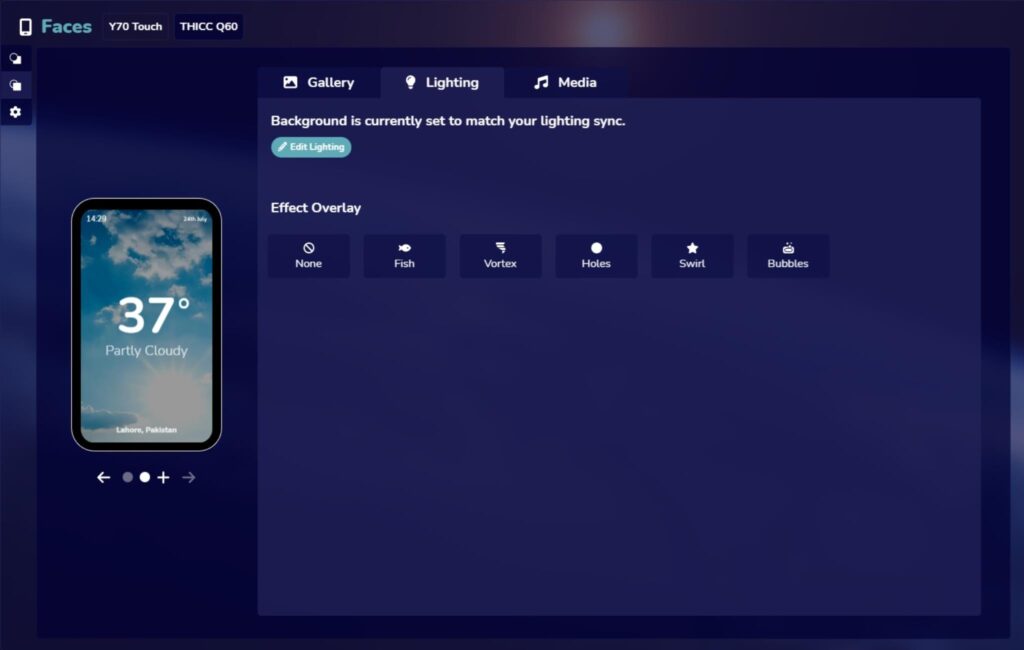
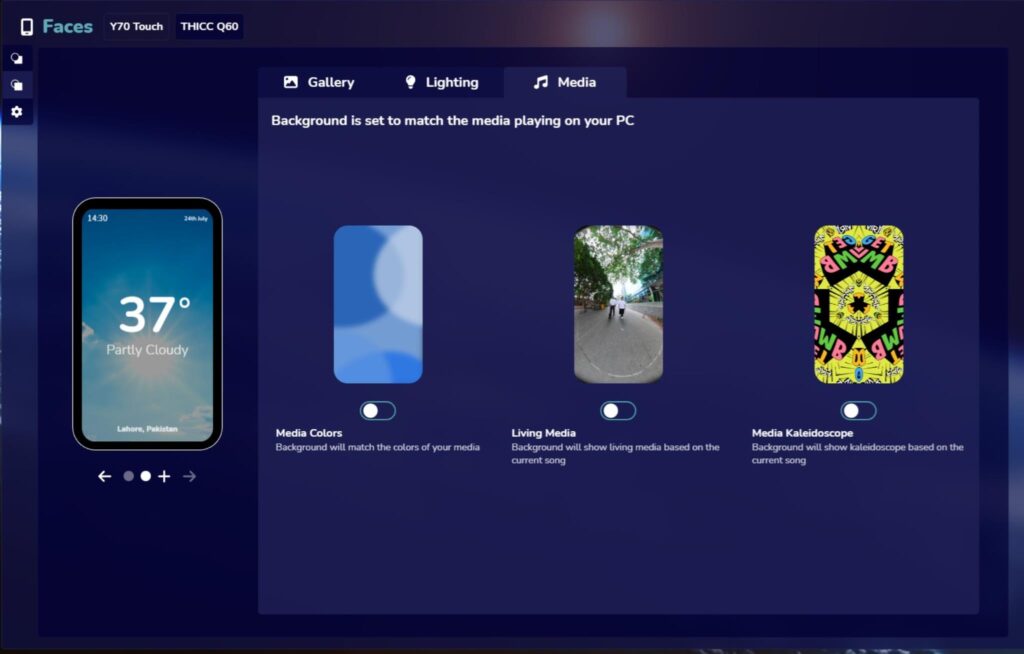

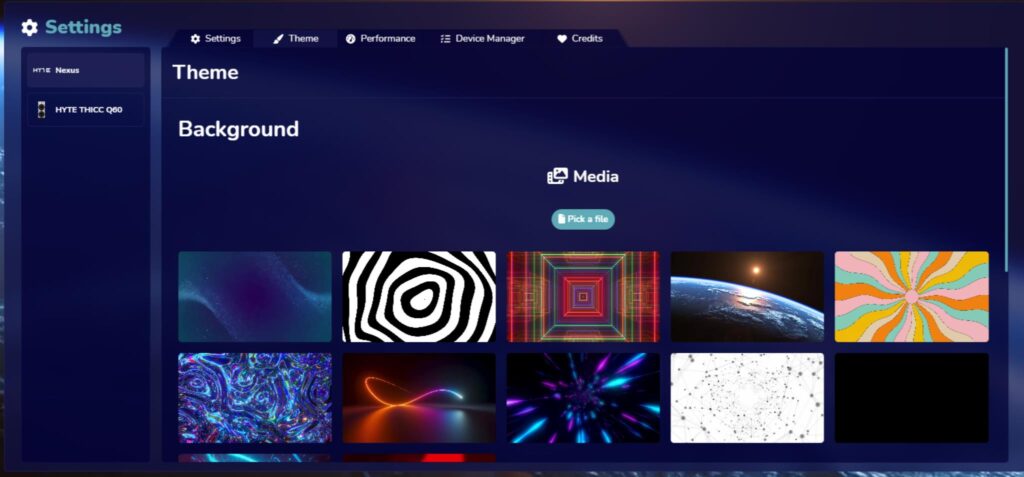
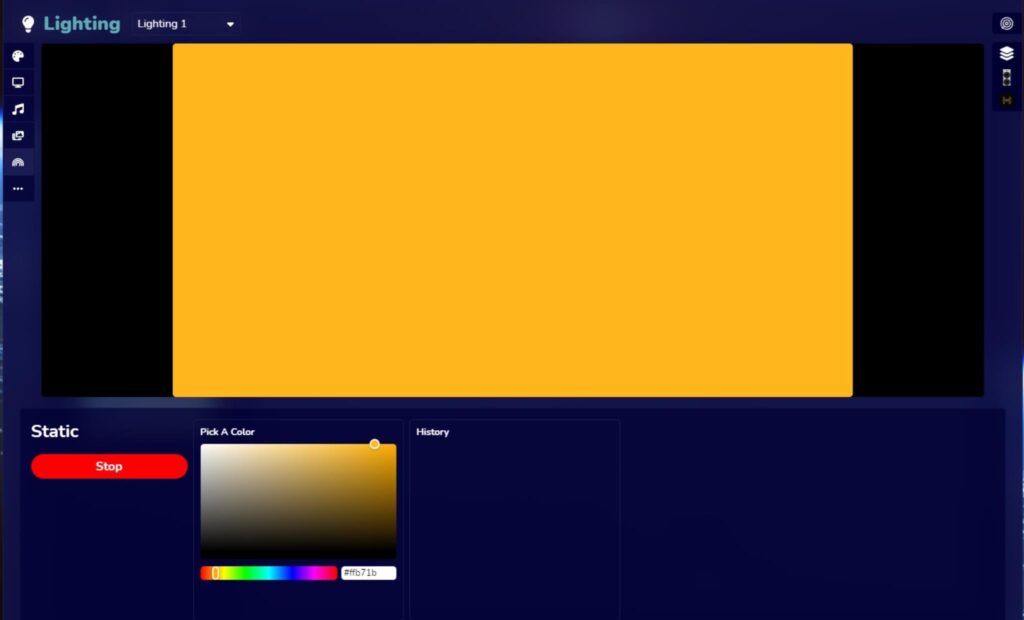
You can download the Nexus software from HYTE website. This is a comprehensive software but I am afraid, it is not user friendly particularly when it comes to the display screen handling. The software is complex and its depth makes it even further complicated particularly when it comes to operating the A-RGB lighting. However, the performance of the cooler is easily controllable.
How to control the performance?
Nexus software has provided three modes to control the performance of the cooler by adjusting the speed of the fans and pumps.
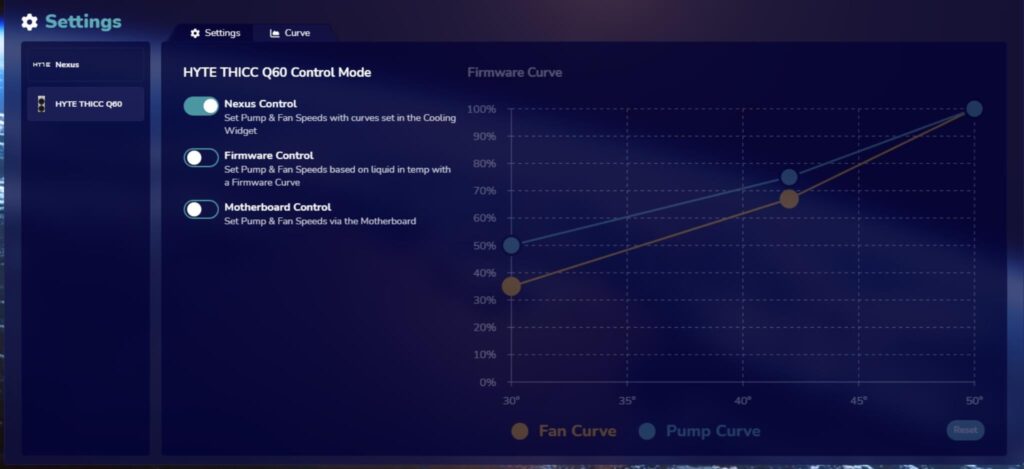
- Nexus Control
- Firmware Control
- Motherboard Control
The firmware control is based on the liquid/coolant’s temperature. It is the most silent based control though the overall temperature of the CPU was on the high side under this control.
The motherboard control transfers the control from the unit to the motherboard for which the provided PWM connector must be connected to the CPU_Fan or any other header. It will report the pump speed only and not the fans’ speed. This is its disadvantage just like the ARCTIC Liquid Freezer II series coolers.
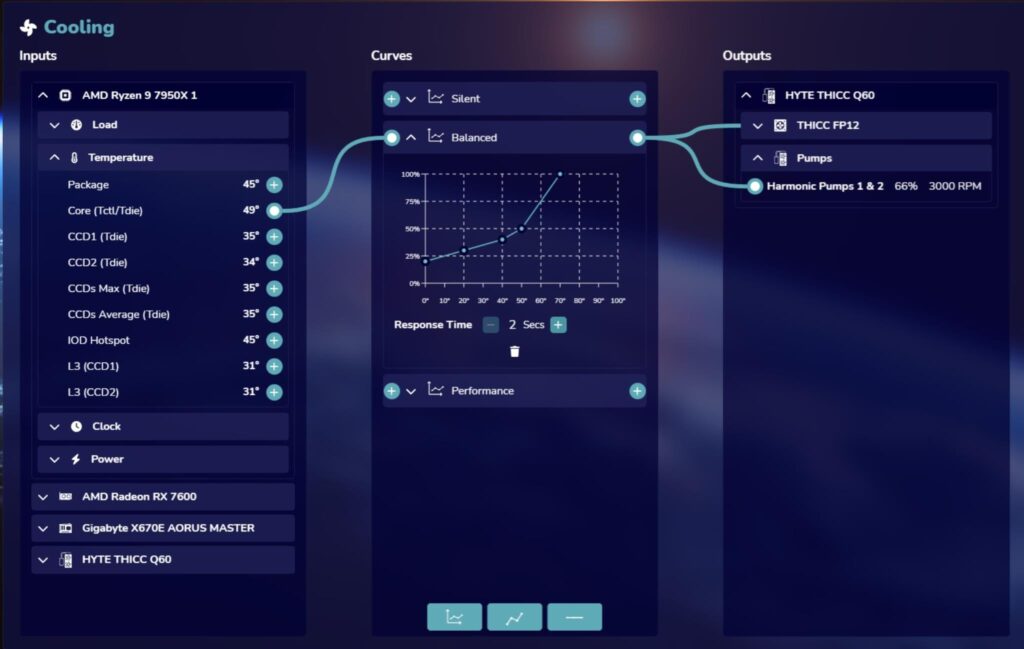
The Nexus Control uses predefined profiles. However, you would need to set the things up. You first need to provide the input source. This is a source on which the speed will be regulated. I have used CPU tCtl/tDie as an input sensor. Just drag the sensor name towards the pre-defined modes (Silent, Balanced, and Performance). Then you can map the curves with the outputs. Outputs here refer to the fans and the pumps.
Testing
I have used below mentioned configuration: –
- AMD Ryzen 7950X
- GIGABYTE X670E AORUS MASTER
- Kingston Renegade Fury 32GB 6400MHz CL32 DDR5 kit
- ASRock Phantom Gaming RX 7600 Graphics Card for Display
- Sabrent Rocket 4 Plus 2TB NVME SSD
- Be quiet! Straight Power 11 1000W Platinum PSU
- Open-Air Test Bench
Here is the settings table for testing:
| Clock (MHz) | Auto |
| Voltage (V) | Auto |
| PBO | Advanced |
| PPT | 200000mW |
| TDC | 480000 |
| EDC | 640000 |
| Platform Thermal Throttle Limit | Auto |
| Thermal Paste | Stock |
| Thermal Paste Application | Pre-applied |
| Test Run Time | 30 minutes |
| Idling Time | 10 minutes |
| All Fans Speed | 100% PWM Duty Cycle |
| Pump Speed | |
| Stress Software | CINEBENCH R23.2 |
| Monitoring Software | HWINFO64 |
We are reporting delta temperature in the graph because room temperature varied from 20.9°C to 22.8°C throughout the day. The testing is done on an open air bench system. Once inside the chassis, the temperatures are expected to rise and would largely depend upon the optimal airflow inside the chassis.
Result
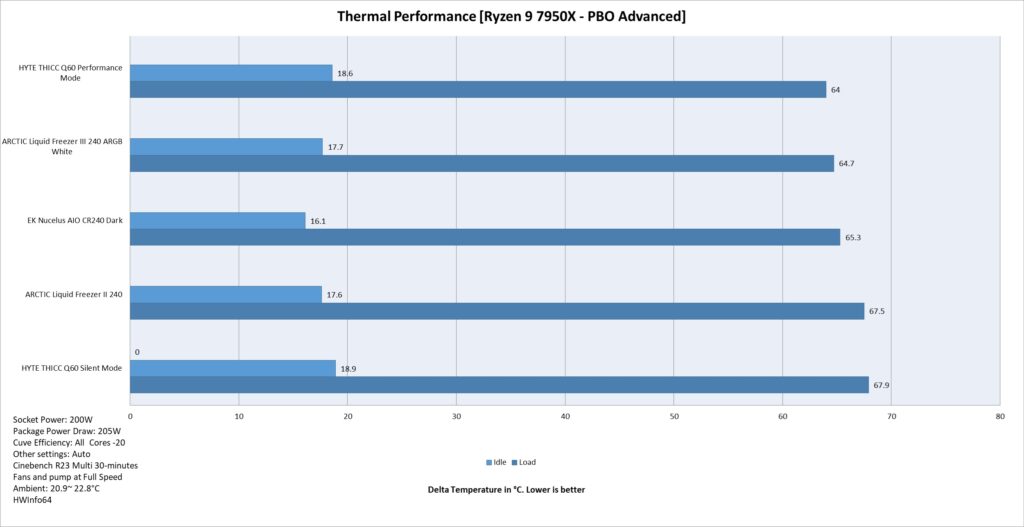
I have tested the cooler using Silent and Performance modes. The performance of this cooler over the AM5 platform seems competitive but it is not giving any value since the other coolers cost much less than this cooler and actually they offer the competitive performance. However, this performance is observed on the AM5 platform only. In my testing of this unit on Intel, this cooler offers a performance level of some top notch 360mm AIOs (that is a topic for another content).
Coming to sound output, these fans and pumps at full speed make a sound level of 51 dBA. This is the highest that any cooling unit has made on my test bench beating the 50.2 sound output on Lian Li GALAHAD III Trinity Performance edition. However, the unit was doing 44 dB(A) on the firmware control but CPU temps were high.
Conclusion
I have taken a look at the premium cooling solution from HYTE named THICC Q60. THICC here literally means a 52mm thick radiator and 88mm thick radiator and fans assembly. HYTE has aimed at providing the maximum thickness hence more surface area in a 240mm size radiator hoping to match a cooling performance of 360mm AIOs.
This unit has a 288x120x52mm sized aluminum radiator with FPI count of 14 and 10 channels. This unit is Nexus powered which is why it is a cable free cooling solution. HYTE has used 400mm long CIIR material tubes with nylon sleeves. These are thicker tubes compared to the standard AIOs and the cable connections are routed under the sleeve of these tubes.
The radiator assembly is finished in black and white which really looks nice in person. This is further augmented by two PF12 fans which are also in black and white. The fans come pre-installed over the radiator in a pull configuration which may imply that this cooler is for HYTE Y60/Y70 side mount fulfilling the HYTE Ecosystem driven by Nexus Link.
The dual harmonic pumps are integrated into the radiator housing. HYTE has even concealed the cables coming out from these pumps. These are rated for 2000 to 4500 RPM speed and use ceramic bearings with 24mm diameter impeller. The coolant is rated for -10ᵒC to 60ᵒC and there is an integrated sensor to monitor the temperature of the coolant.
These fans have a magnetic connection and each fan has dual Nexus Link ports for input and output. The radiator assembly has dual channels to complete the connection. CORSAIR take a note from this for your new cooler. The fans’ frame is made of polycarbonate material whereas the blades are made of fiberglass reinforced liquid polymer crystal material which reminds me of Noctua NF-A12x25 fans.
These fans are rated for 0 – 3000 RPM speed generating a massive 105.8 CFM airflow at an impressive 8.14 mmH₂O air pressure. These fans use fluid dynamic bearing. These fans have Nexus Link Type-M connection.
There are a total of 3 USB C ports on the radiator assembly. The main connection points are two USB Type-C ports located on an inset on one side. The bundled Nexus Link cable has a dual USB C connector that is used to establish a connection with the radiator. The other end of the cable has a 6-pin PCIe connector, a 9-pin USB 2.0 connector, and a 4-pin PWM connector. The power rating of a single channel is 8A/12VDC with maximum rating of both channels of 15A/12VDC. The unit can draw a maximum of 180W power in case 34 devices are connected to both channels.
Now coming to the main attraction of the unit which is 5” IPS Display screen packing 720×1280 resolution at an 293 PPI and a refresh rate of 60Hz. The brightness is 300 nits. This screen has 42-pixel qRGB Array Bias lighting. There is a diffuser over the backside of the screen that lights up good. Controlling the main action on this screen is quad-core 64-bit ARM Cortex processor. It is rated for 1.3GHz speed and uses 2GB DDR4 RAM at 2666MT/s. the graphics power comes from 32-bit ARM M4 processor having 500MHz speed. The screen is connected to the main block using double hinged floating spouting.
The installation over AMD AM5 platform is simple and it involves 6 items to install the block/screen in 3 steps. This is by far the easiest and simplest installation that I have ever seen. Also, this is the first cooler to have only 3 steps in the installation. HYTE has used the similar LGA1700 standoffs screws as I saw on some other coolers like SilverStone ICEMYST 360, InWin MR360, and Teamgroup Diren DUO 360. These screws are double threaded and while they are easy to install, their removal is not particularly the one that sits in the corner near to the capacitors. Many a times, I have to use a large flat head plier to unhook these screws. This could easily damage the motherboard as well as the threads on these screws. Hey HYTE, either skip these screws by integrating the screws on the backplate or provide a tool like EKWB does that makes life easy.
Now, coming to the performance evaluation, this cooler is on par with other 240mm AIOs on AMD AM5 platform. This is something I was not expecting as I was hoping to see the performance level of 360mm AIO. However, my testing on Intel platform confirmed that this cooler indeed provide that level of performance. It is a bit weird seeing radical performance levels on two platforms from same unit. The Nexus Software is not easy and you will need to spend time with the software to get hang of this. You can use either the predefined modes to control the fans and pumps or set them based on the coolant’s temperature as well as a total motherboard based control in which you can’t control the speed of fans and pumps individually.
HYTE offers a 6-year warranty on this cooler which is a good number. Based on our AM5 testing, this unit provides a competitive performance given the other 240mm size coolers but it is not adding any value since other coolers cost significantly less compared to USD 300 price tag on THICC Q60.
Pros:
- Competitive Thermal Performance
- Nexus Powered
- Cable Free Solution – Welp almost
- 5” IPS Screen
- Digital Processing Unit
- Double-Hinged Floating Sprout
- Integrated Cable Management
- Ability to control all fans and pump individually using Nexus Software
- Adjusting performance of fans and pumps based on coolant’s temperature
- Pre-Installed PF12 Fans
- Compatible with Intel LGA1700/1851 sockets
- Compatible with AMD AM4/AM5 sockets
- Improved Cold Plate design
- Dual-Harmonic Pumps integrated into the radiator housing
- Easy Installation
- 6-Year Warranty
Cons:
- Limited PC Case Support
- Sound Level at 100% speeds
- Pricing
- Software is not easy
- Single control for all fans and pumps in motherboard control mode












